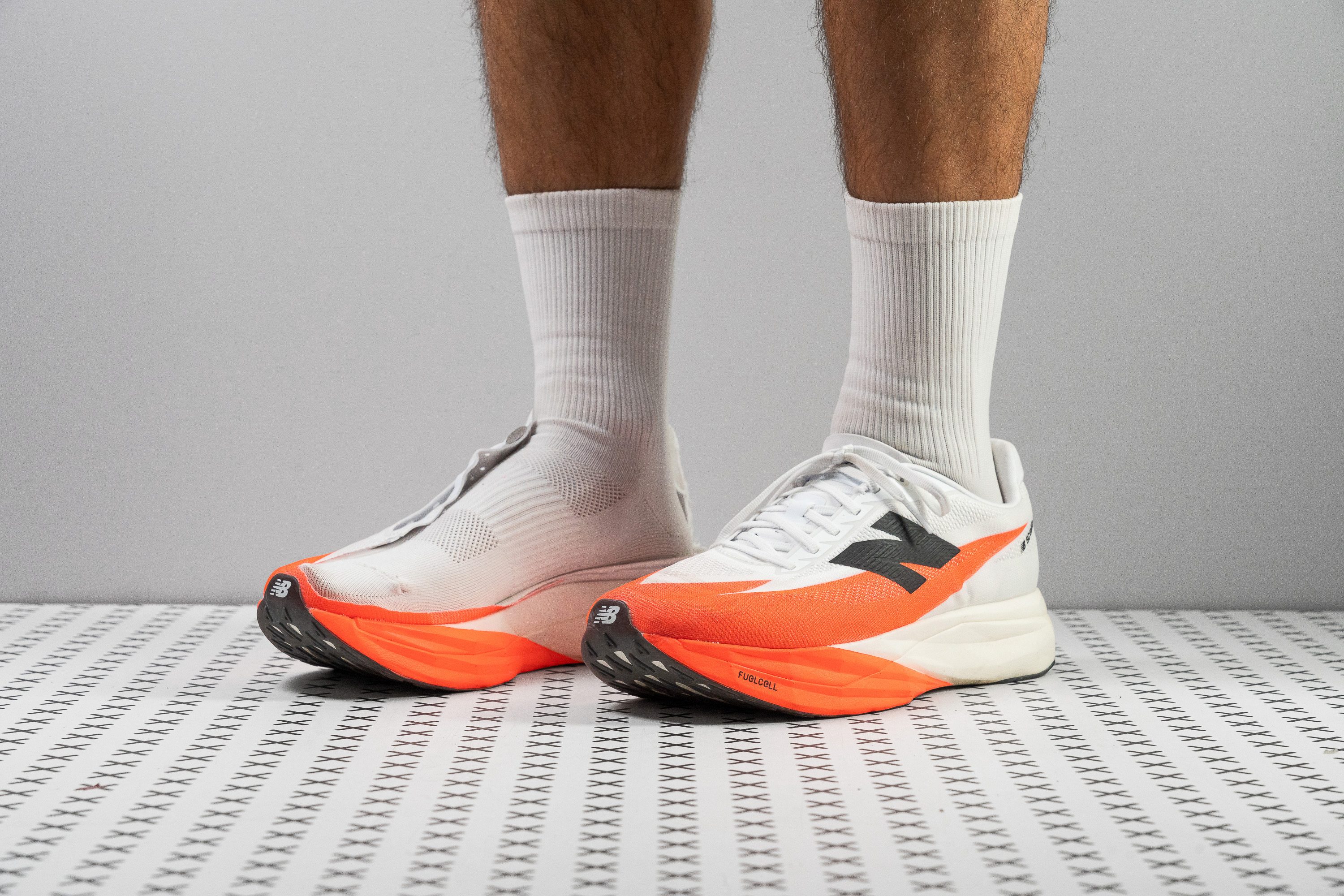Our verdict
- Top pick in best New Balance running shoes
- Top pick in best cushioned New Balance running shoes
Pros
- Improved performance and speed
- Roomy toebox (for a competition shoe)
- Maxed-out heel stack
- Much lighter than before
- Strong grip from new outsole design
- Redesigned plate curvature for faster transitions
- Premium, breathable upper
- Fixes heel and tongue issues from v4
Cons
- Still not among the fastest supershoes
- Narrow heel reduces stability
- High drop may not suit everyone
- Comes without high-grip laces
Audience verdict
- Top 5% in road running shoes
- Top 4% in New Balance running shoes
- Top 10% most popular running shoes
Comparison
The most similar running shoes compared
+ + Add a shoe | |||||
|---|---|---|---|---|---|
| Audience score | 92 Superb! | 90 Superb! | 89 Great! | 89 Great! | |
| Price | $265 | $230 | $275 | $250 | |
| Pace | Competition | CompetitionTempo | CompetitionTempo | Competition | |
| Shock absorption | High | High | High | High | |
| Energy return | High | High | High | High | |
| Traction | High | High | Moderate | High | |
| Arch support | Neutral | Neutral | Neutral | Neutral | |
| Weight lab Weight brand | 7 oz / 198g 7.5 oz / 213g | 7.2 oz / 204g 7.4 oz / 209g | 7.3 oz / 208g 7.4 oz / 210g | 7.8 oz / 220g 7.4 oz / 210g | |
| Lightweight | ✓ | ✓ | ✓ | ✓ | |
| Drop lab Drop brand | 10.7 mm 8.0 mm | 10.6 mm 8.0 mm | 10.7 mm 7.0 mm | 10.0 mm 7.0 mm | |
| Strike pattern | Heel | Heel | Heel | HeelMid/forefoot | |
| Size | True to size | True to size | True to size | Slightly small | |
| Midsole softness | Soft | Soft | Soft | Soft | |
| Difference in midsole softness in cold | Small | Normal | Big | Small | |
| Toebox durability | Bad | Bad | Bad | Decent | |
| Heel padding durability | Decent | Good | Bad | Good | |
| Outsole durability | Decent | Decent | Decent | Good | |
| Breathability | Moderate | Moderate | Breathable | Breathable | |
| Width / fit | Medium | Medium | Narrow | Narrow | |
| Toebox width | Medium | Narrow | Medium | Narrow | |
| Stiffness | Moderate | Stiff | Stiff | Stiff | |
| Torsional rigidity | Stiff | Stiff | Stiff | Stiff | |
| Heel counter stiffness | Flexible | Flexible | Flexible | Flexible | |
| Plate | Carbon plate | Carbon plate | Carbon plate | Carbon plate | |
| Rocker | ✓ | ✓ | ✓ | ✓ | |
| Heel lab Heel brand | 39.3 mm 40.0 mm | 39.2 mm 40.0 mm | 38.8 mm 46.0 mm | 39.6 mm 40.0 mm | |
| Forefoot lab Forefoot brand | 28.6 mm 32.0 mm | 28.6 mm 32.0 mm | 28.1 mm 39.0 mm | 29.6 mm 33.0 mm | |
| Widths available | NormalWide | Normal | Normal | Normal | |
| Orthotic friendly | ✓ | ✓ | ✓ | ✓ | |
| Season | All seasons | All seasons | SummerAll seasons | SummerAll seasons | |
| Removable insole | ✓ | ✓ | ✓ | ✓ | |
| Ranking | #12 Top 4% | #38 Top 11% | #102 Top 28% | #100 Top 28% | |
| Popularity | #35 Top 10% | #49 Top 14% | #368 Bottom 1% | #62 Top 17% |
Who should buy
After finishing our lab tests, we concluded that the FuelCell SuperComp Elite v5 is ideal for:
- Fans of New Balance who want to stick with the brand and get its best competition shoe yet.
- Runners who love the classic look & feel of racing flats but want the performance of a modern racer.
- Those looking for a supershoe with a slightly roomier toebox for extra comfort.
- Marathoners who found version 4 too heavy, as the new model is much lighter and agile.
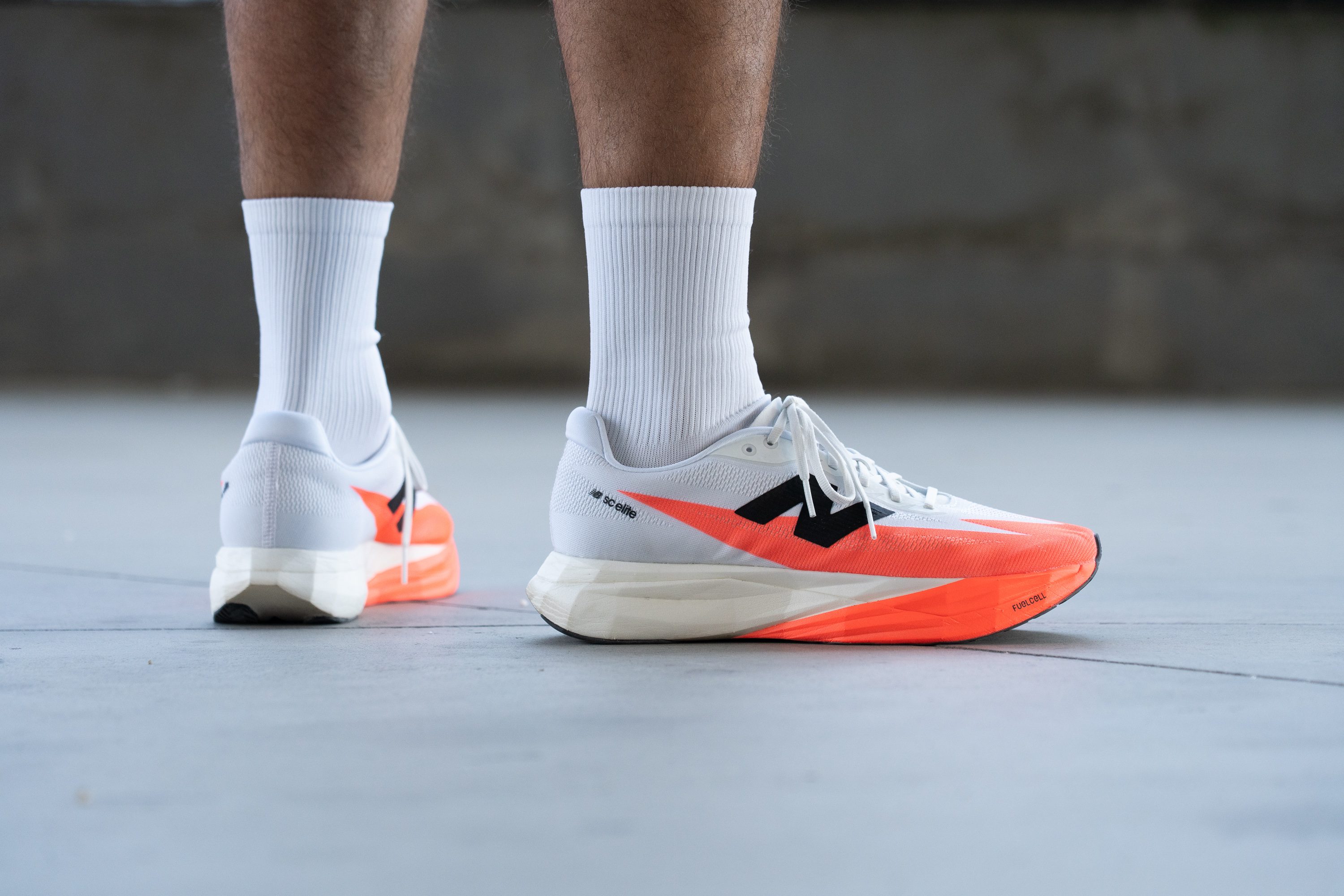
Who should NOT buy
We think the Elite v5 isn’t the best choice for runners who need stability. After testing it, we found that its compact build sacrifices support, making it better suited for neutral runners with precise form. In our view, those looking for a bit of stability in a supershoe should consider the Nike Alphafly 3, which offers a broader and more supportive base.
Additionally, while the v5 is lighter than its predecessor, it still feels on the heavier side compared to top-tier racing models. Based on our findings, if weight is your main concern, we believe the ASICS Metaspeed Ray and the Nike Vaporfly 4 are excellent picks.
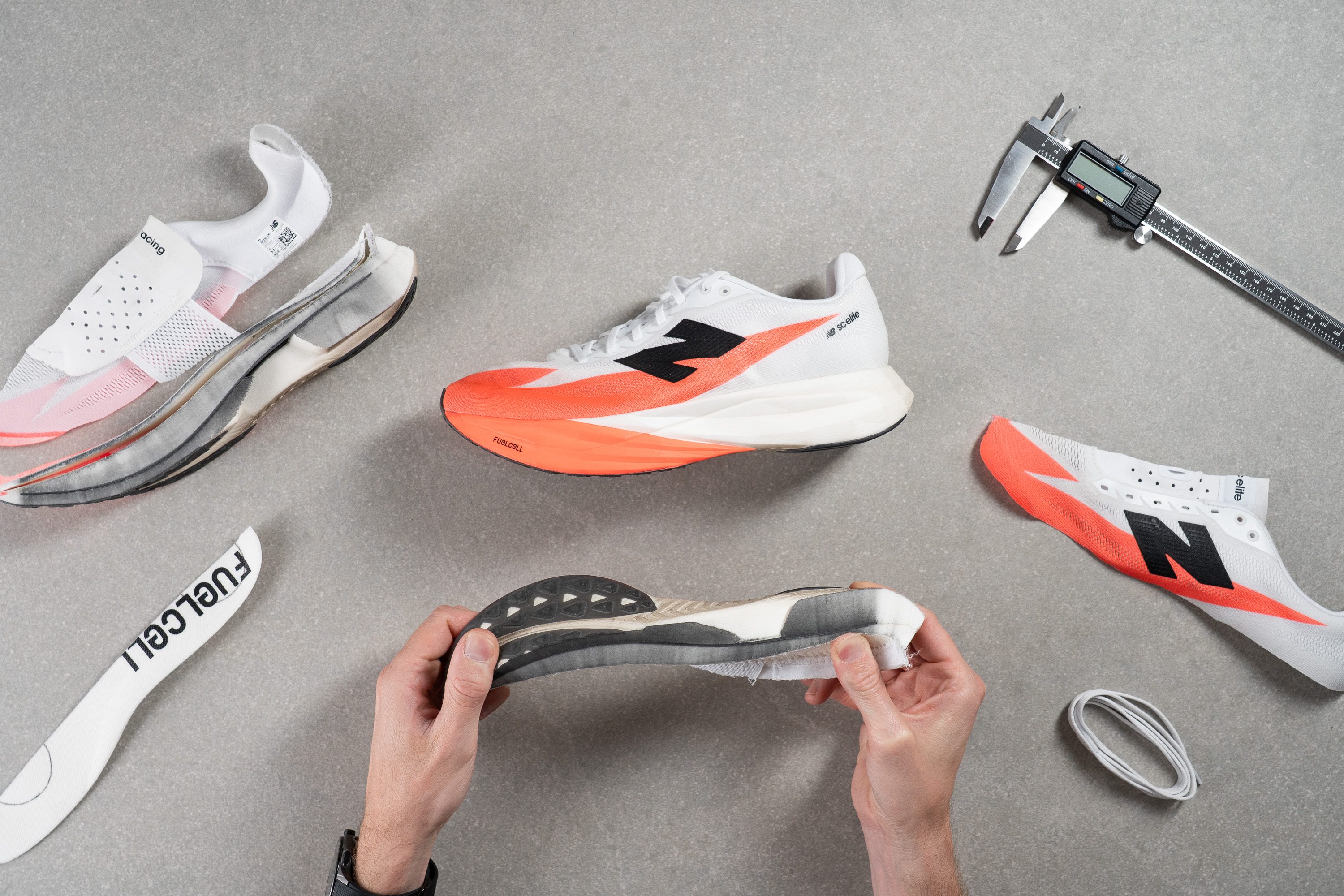
Cushioning
Shock absorption
We tested the New Balance FuelCell SuperComp Elite v5 in our lab and confirmed that it provides solid shock absorption in both the heel (144 SA) and forefoot (112 SA).
However, the front is slightly less cushy than some competitors, which might discourage heavier forefoot strikers from using it for marathons. For everyone else, though, there’s plenty of protection for any distance.
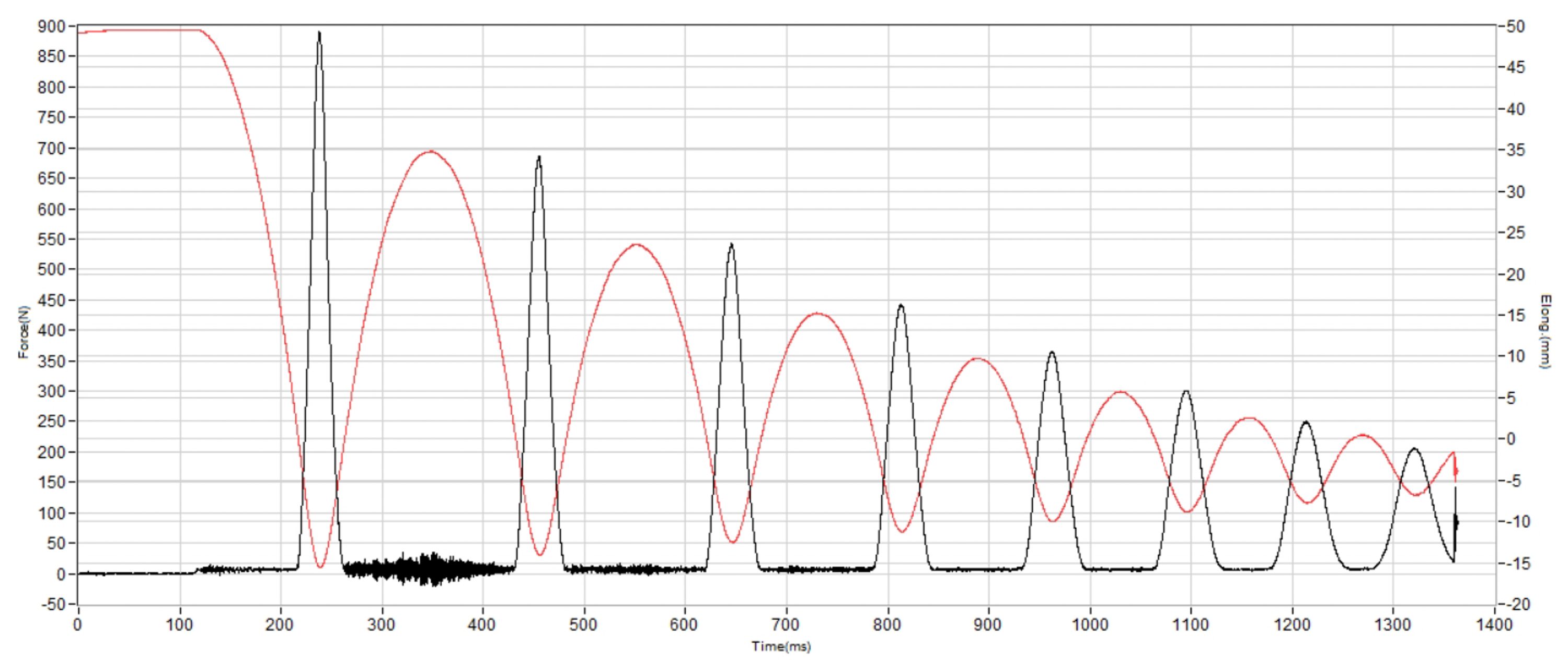
| FuelCell SuperComp Elite v5 | 144 SA |
| Average | 129 SA |
Energy return
The PEBA-based FuelCell midsole of the Elite v5 (we still wish it had another name to avoid confusion with the EVA+PEBA combo of the FuelCell Rebel v5) sits firmly at the high-performance end of the spectrum, right where it should be for New Balance to compete with the best supershoes.
We measured energy return at 74.8% in the heel and 74.9% in the forefoot, both very solid numbers. However, it seems like the Elite always trails slightly behind top-tier supershoes from Adidas, ASICS, and Saucony, which are now close to or even surpass 80% in our lab tests.
| FuelCell SuperComp Elite v5 | 74.8% |
| Average | 58.6% |
Heel stack
The heel stack of the SuperComp Elite v5 delivers exactly what most runners expect from a top-tier supershoe: getting as close as possible to the 40 mm limit. We measured it at an impressive 39.3 mm.
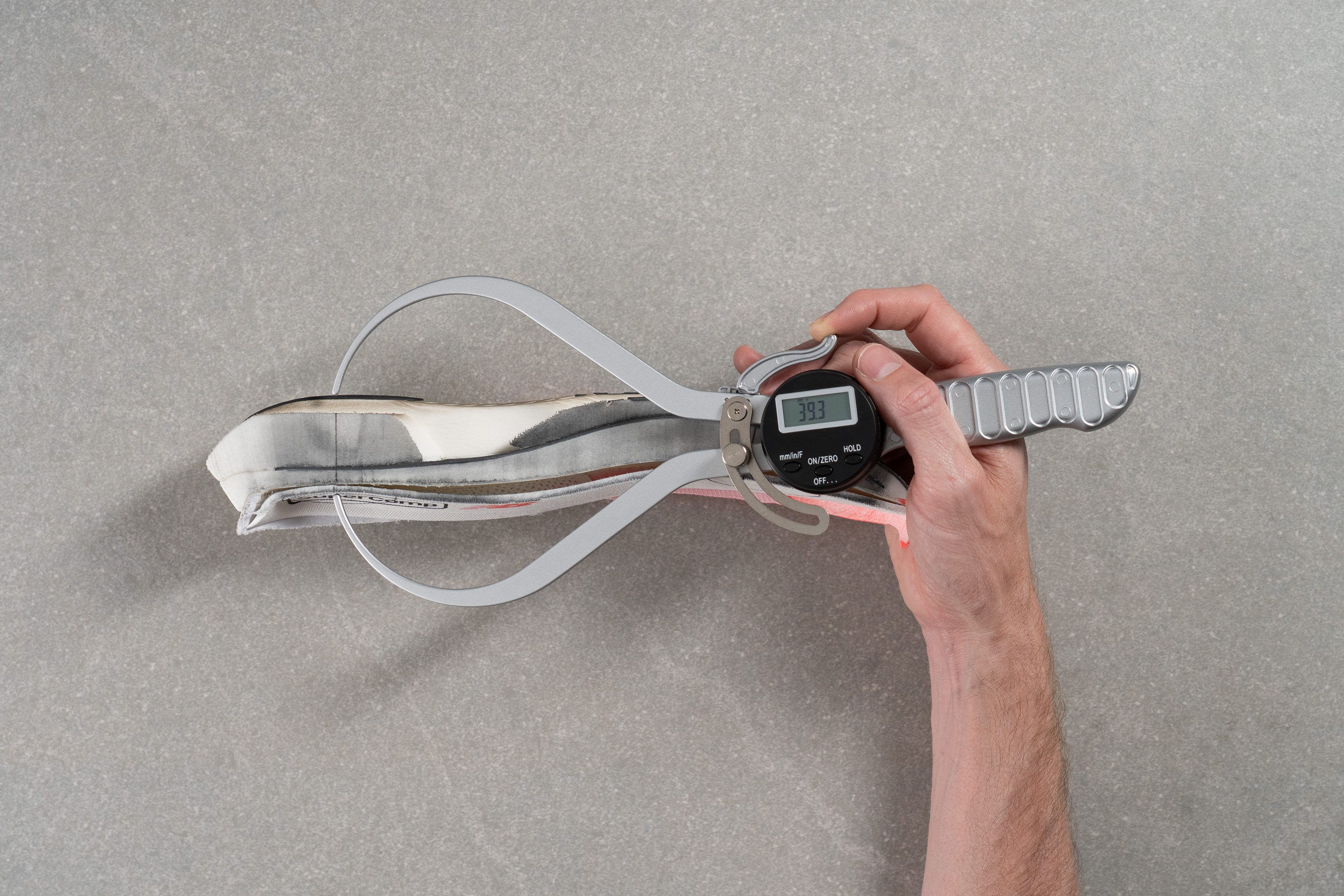
| FuelCell SuperComp Elite v5 | 39.3 mm |
| Average | 34.8 mm |
Forefoot stack
On the other hand, the forefoot is noticeably thinner, dropping below the 30 mm mark at 28.6 mm. This setup might not appeal to forefoot strikers who prefer a thicker, more cushioned platform like the ASICS Metaspeed Edge Tokyo.
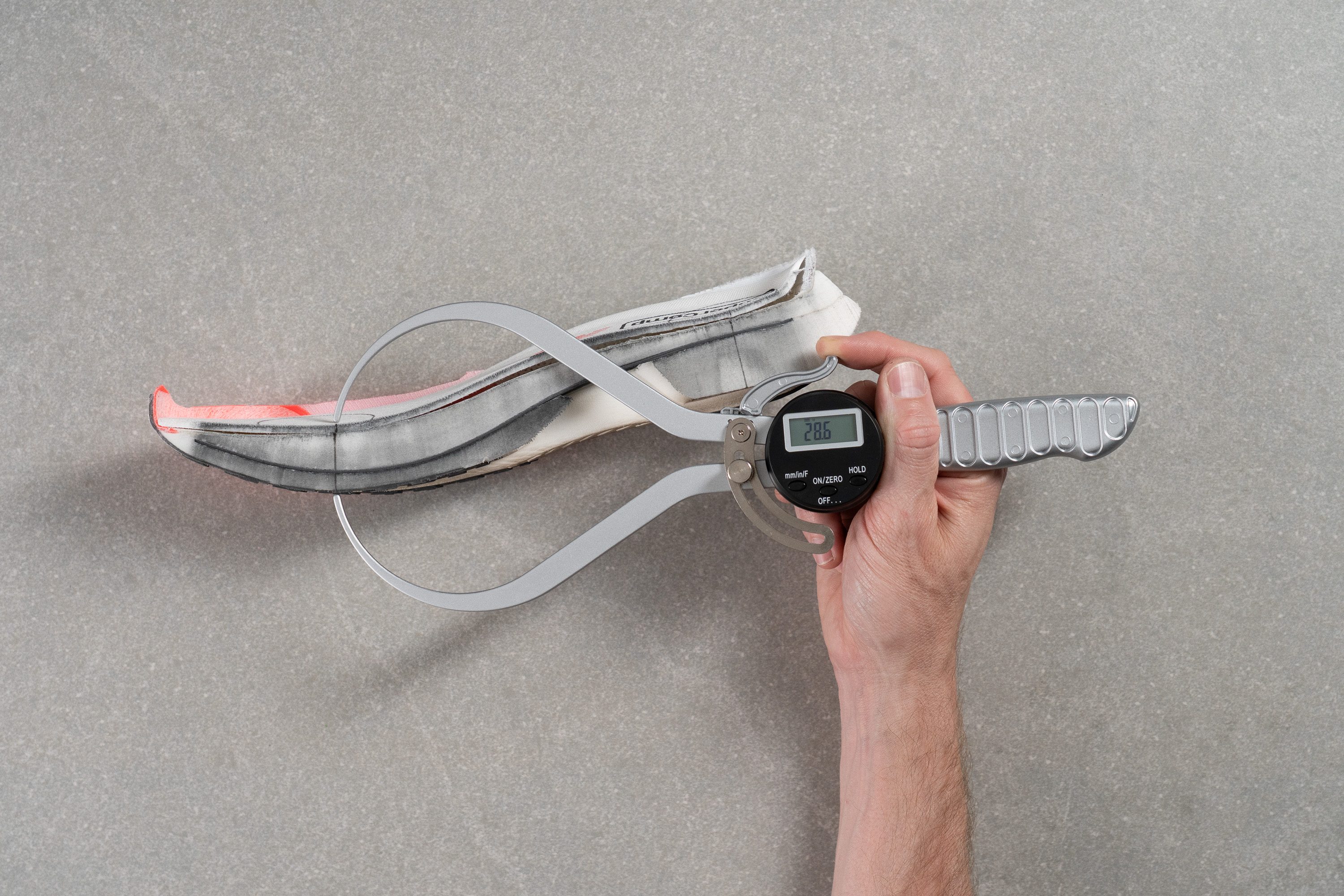
| FuelCell SuperComp Elite v5 | 28.6 mm |
| Average | 26.2 mm |
Drop
New Balance has experimented quite a bit with the drop in the Elite series, first setting an official 4 mm for the v4 (though it measured higher in our lab) and now doubling that to an official 8 mm.
However, when we tested the v5 following World Athletics’ official points, we discovered a 10.7 mm drop. This setup, combined with the new plate and midsole design, creates a running feel that's reminiscent of the original Vaporfly.
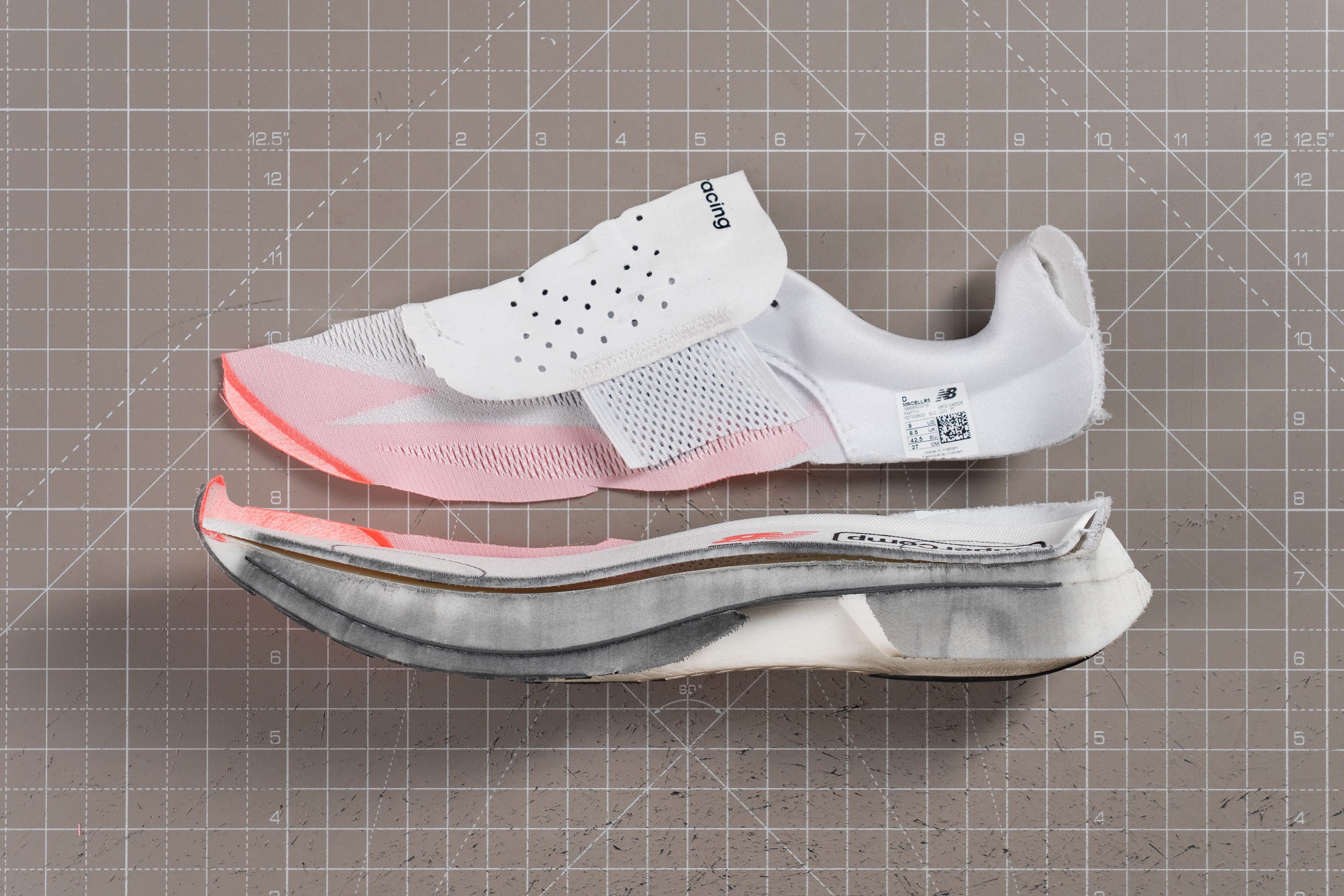
| FuelCell SuperComp Elite v5 | 10.7 mm |
| Average | 8.6 mm |
Midsole softness
This PEBA-based FuelCell foam from New Balance checks all the boxes for a solid superfoam, feeling both soft and energetic underfoot. We measured 15.2 HA of softness in the top layer, and as expected, it features the classic supershoe layout with two foam layers and a carbon plate sandwiched in between.
But it feels to us that New Balance is still two years behind other brands in foam innovation. It happened with the first four editions of the RC/SC Elite, and now it feels the same again.
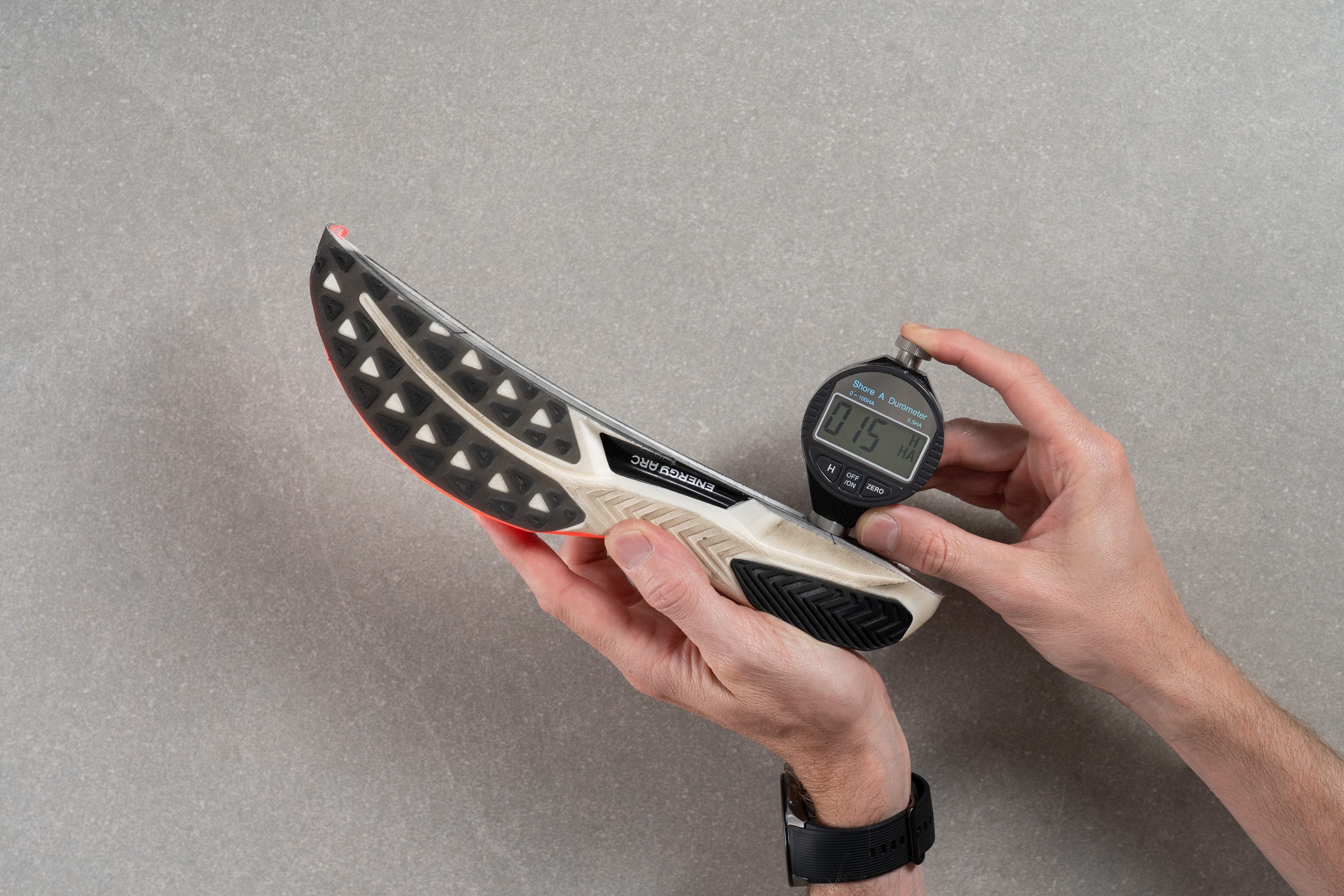
| FuelCell SuperComp Elite v5 | 15.2 HA |
| Average | 20.4 HA |
Secondary foam softness
The secondary layer of FuelCell PEBA foam uses essentially the same compound as the main one, with a nearly identical 15.0 HA reading that's well within normal tolerances.
Unlike other brands that adjust densities for added stability, New Balance kept it simple, and it works nicely for this shoe.
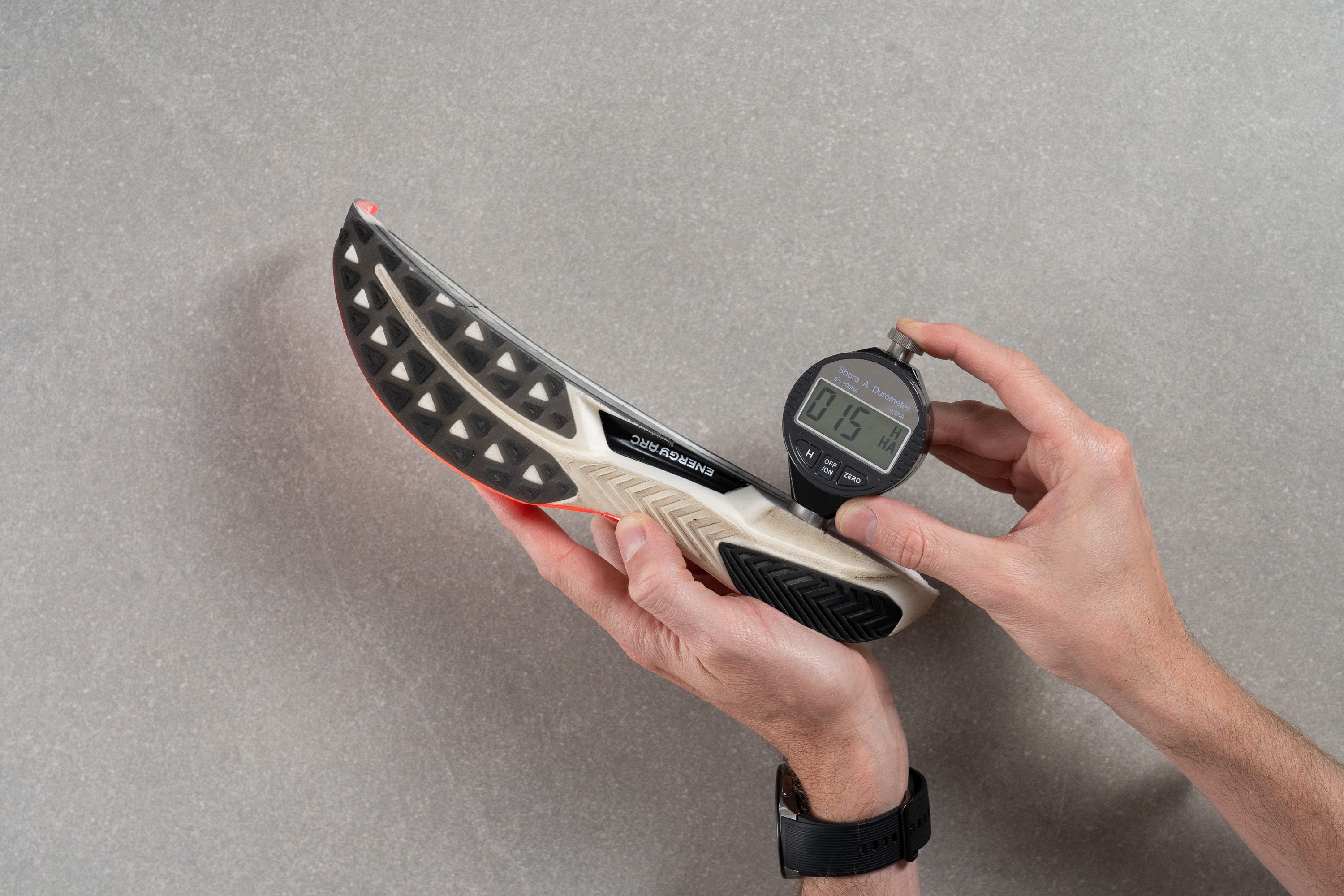
| FuelCell SuperComp Elite v5 | 15.0 HA |
| Average | 22.7 HA |
Rocker
After taking our "mugshot" photo of the rocker, we confirmed exactly what we felt on the run—it’s a superb option for runners who don’t enjoy ultra-aggressive rockers and miss the smooth, grounded feel of old-school racing flats.
The forefoot clearly shows a gentle upward curve, which is inevitable with such a high stack and a carbon plate inside. Still, New Balance kept it moderate and starts pretty late, offering just the right amount of rocker for efficient transitions.
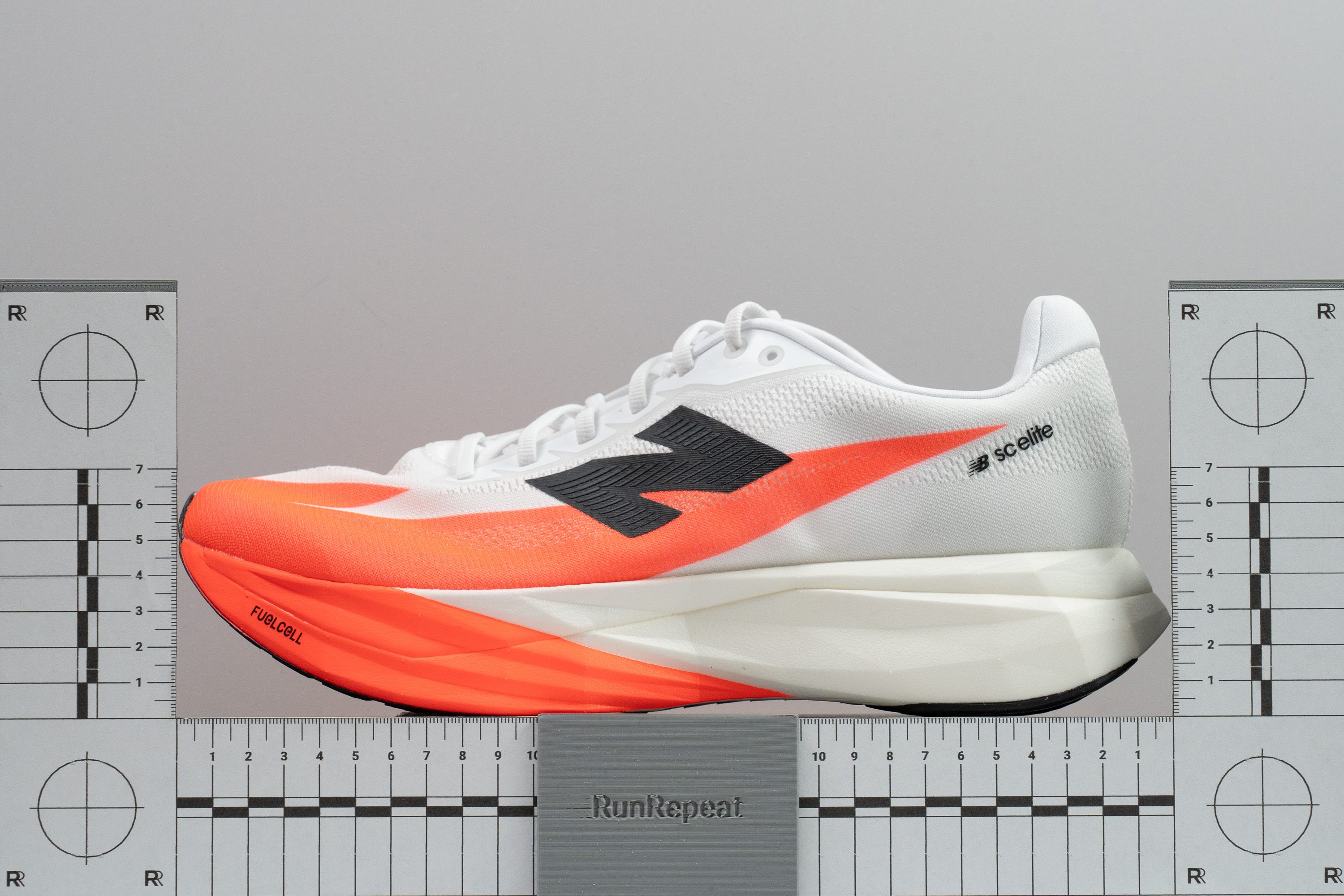
Plate
Another small but meaningful update in the SuperComp Elite v5 comes from its carbon plate. The Energy ARC system is still here with its concave shape, but we discovered it now looks more like a Vaporfly from the side.
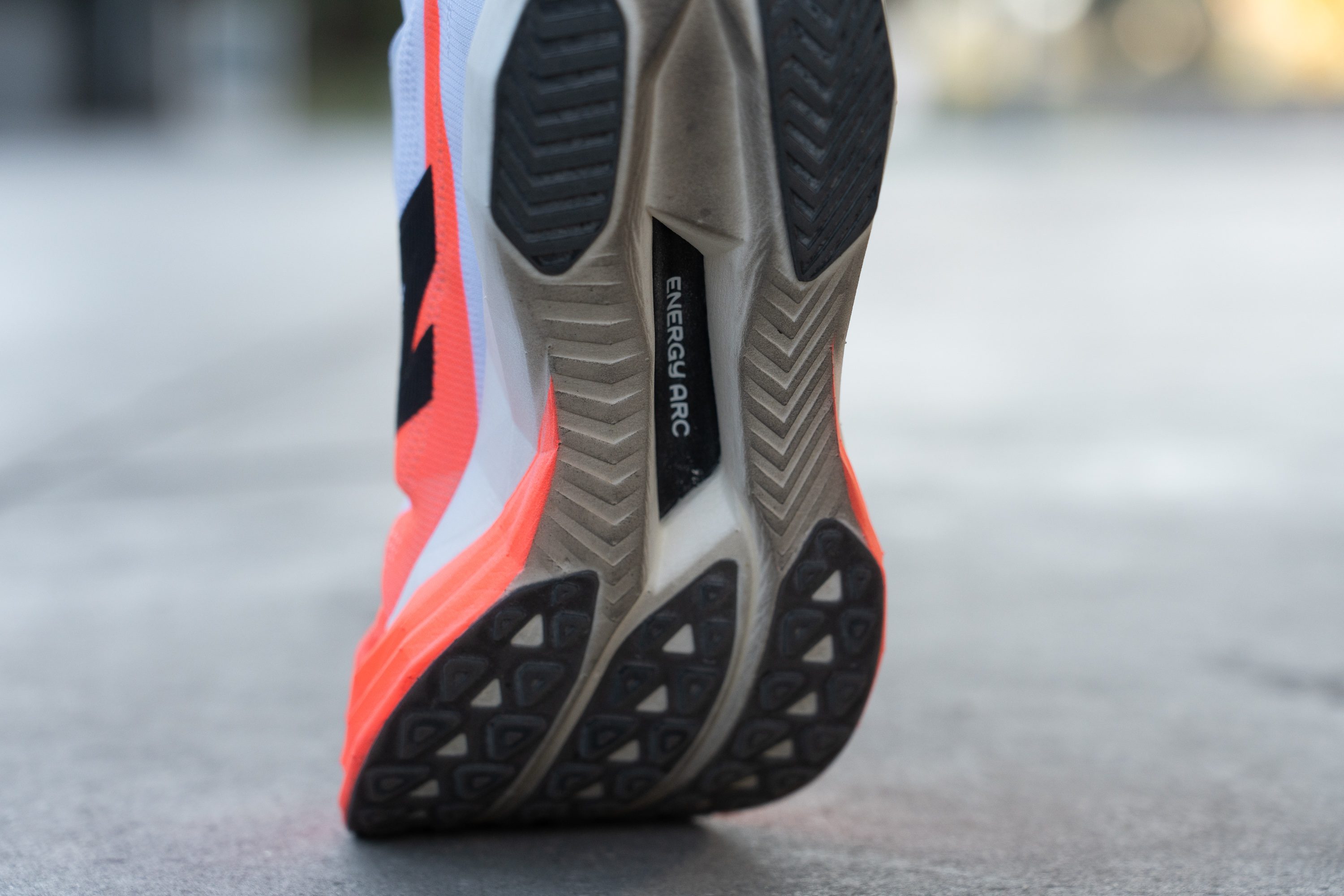
In previous versions, the plate was flatter with a softer leverage point, making the shoe better for beginners or slower-paced long runs but less ideal for high-speed efforts. Now, with this sharper, more aggressive design, it feels far more aggresive and competition-ready.
Size and fit
Size
New Balance FuelCell SuperComp Elite v5 fits true to size (12 votes).
Width / Fit
One of the features that made the SuperComp Elite v4 the best pick for many runners was its wide fit. For a supershoe, it felt unusually spacious, and many runners didn’t mind trading a bit of performance for extra room.
That’s no longer the case in version 5. It now feels more like a regular race-day shoe with a tighter, performance-focused fit. We measured the width at 93.8 mm, noticeably narrower than the 96.0 mm we recorded in the previous model.
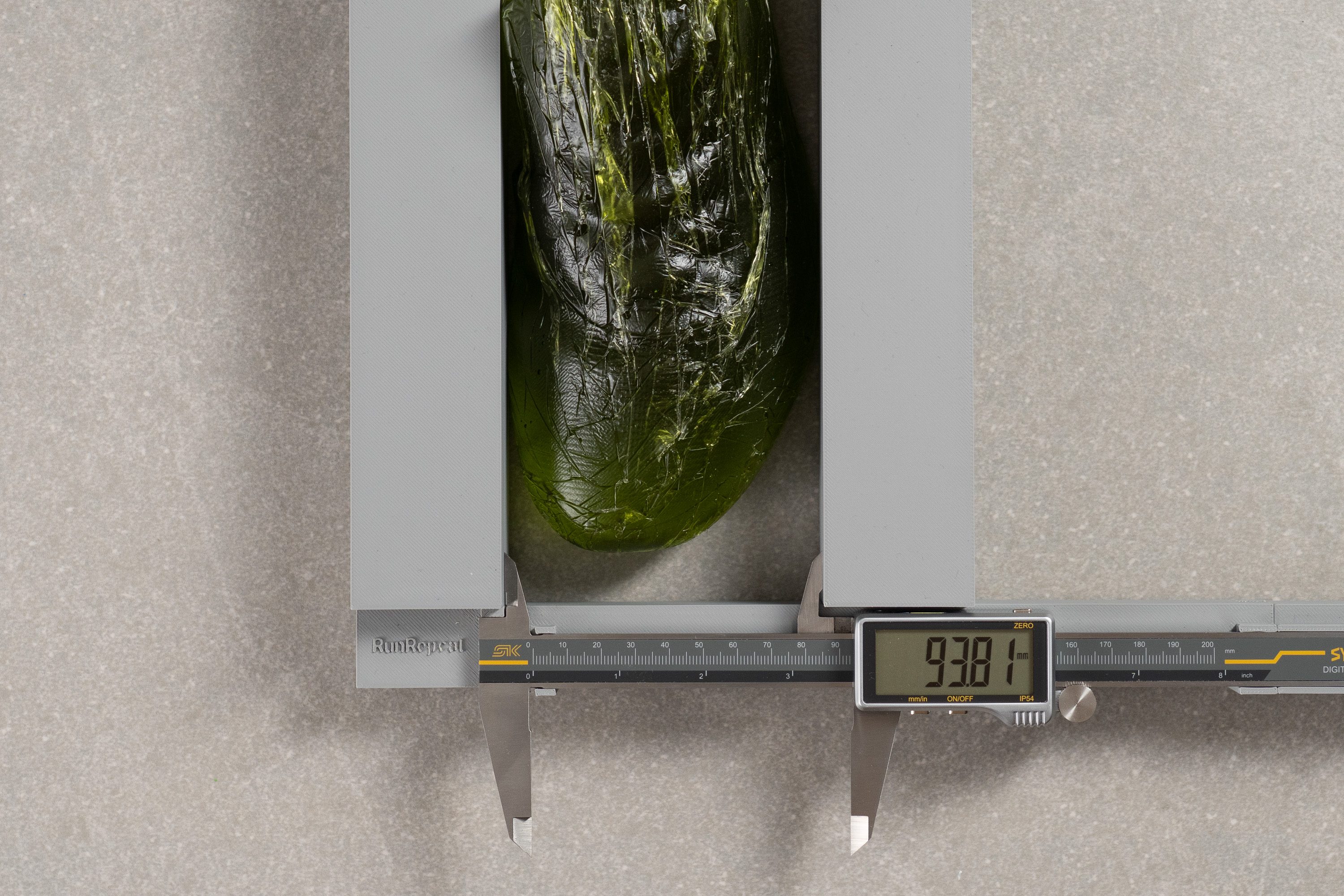
| FuelCell SuperComp Elite v5 | 93.8 mm |
| Average | 95.1 mm |
Toebox width
But there’s still good news. While the 74.5 mm toebox is narrower than the 78.4 mm of version 4, it’s still wider than the average running shoe and even roomier than many daily trainers.
Plus, New Balance remains one of the few brands offering a supershoe in wide sizing, though only in select markets like the US.
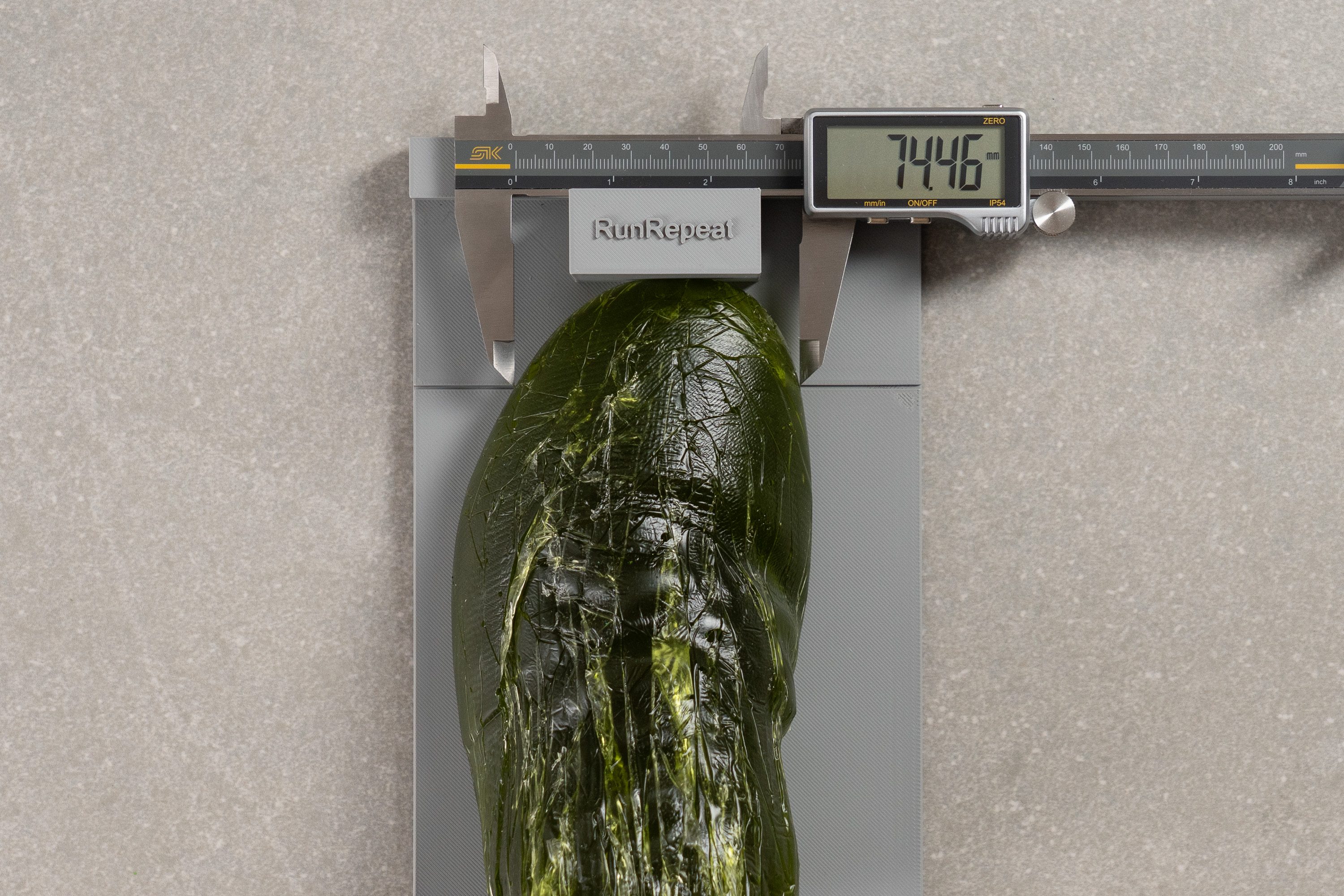
| FuelCell SuperComp Elite v5 | 74.5 mm |
| Average | 73.3 mm |
Toebox height
We also measured the toebox height to confirm the fit from every angle.
At 26.4 mm, it strikes a great balance between a secure lockdown and enough space for natural toe movement. It's just perfect for marathon distances.
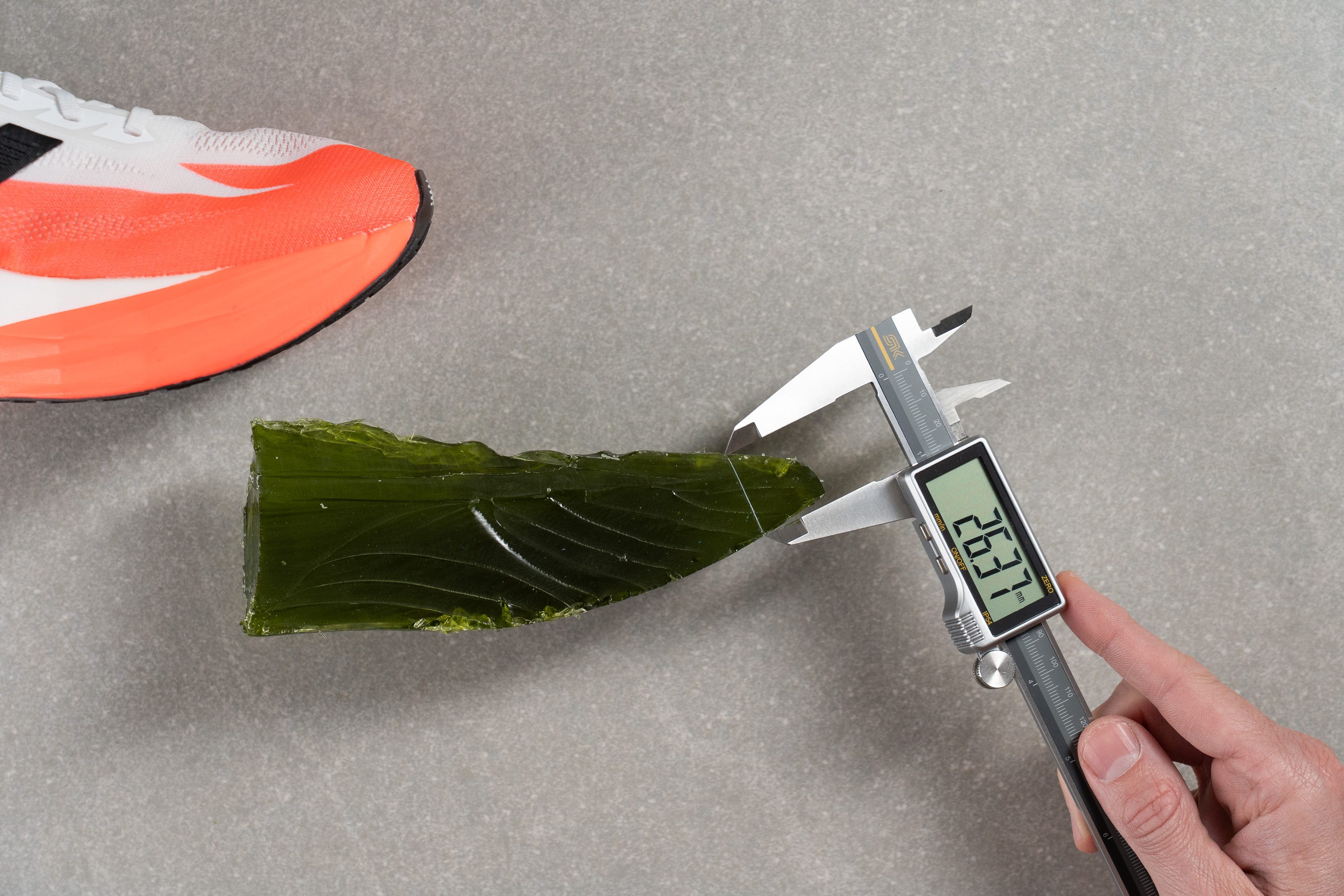
| FuelCell SuperComp Elite v5 | 26.4 mm |
| Average | 27.1 mm |
Traction / Grip
Traction test
Great job by New Balance, as they achieved a strong 0.61 score in our traction test over wet concrete. We found that this result delivers confident, race-ready grip in every weather condition, and it’s 0.15 higher than version 4... while keeping the same price.
This improvement comes from New Balance switching from traditional rubber to a lighter, more advanced polyurethane compound called Ultra Light VPU, similar to the one featured in the Adidas Adizero Adios Pro 4.
| FuelCell SuperComp Elite v5 | 0.61 |
| Average | 0.48 |
Outsole design
Two rectangular pieces protect the heel, while a wide central cutout exposes the Energy Arc plate that runs through the midfoot. In the forefoot, it features triangular lugs and cutouts that extend seamlessly from the midfoot to the toe area.
In our view, it’s clear that the outsole of the Elite v5 provides generous coverage for a supershoe, once again showing that New Balance prioritizes durability over extreme weight savings seen in other brands.
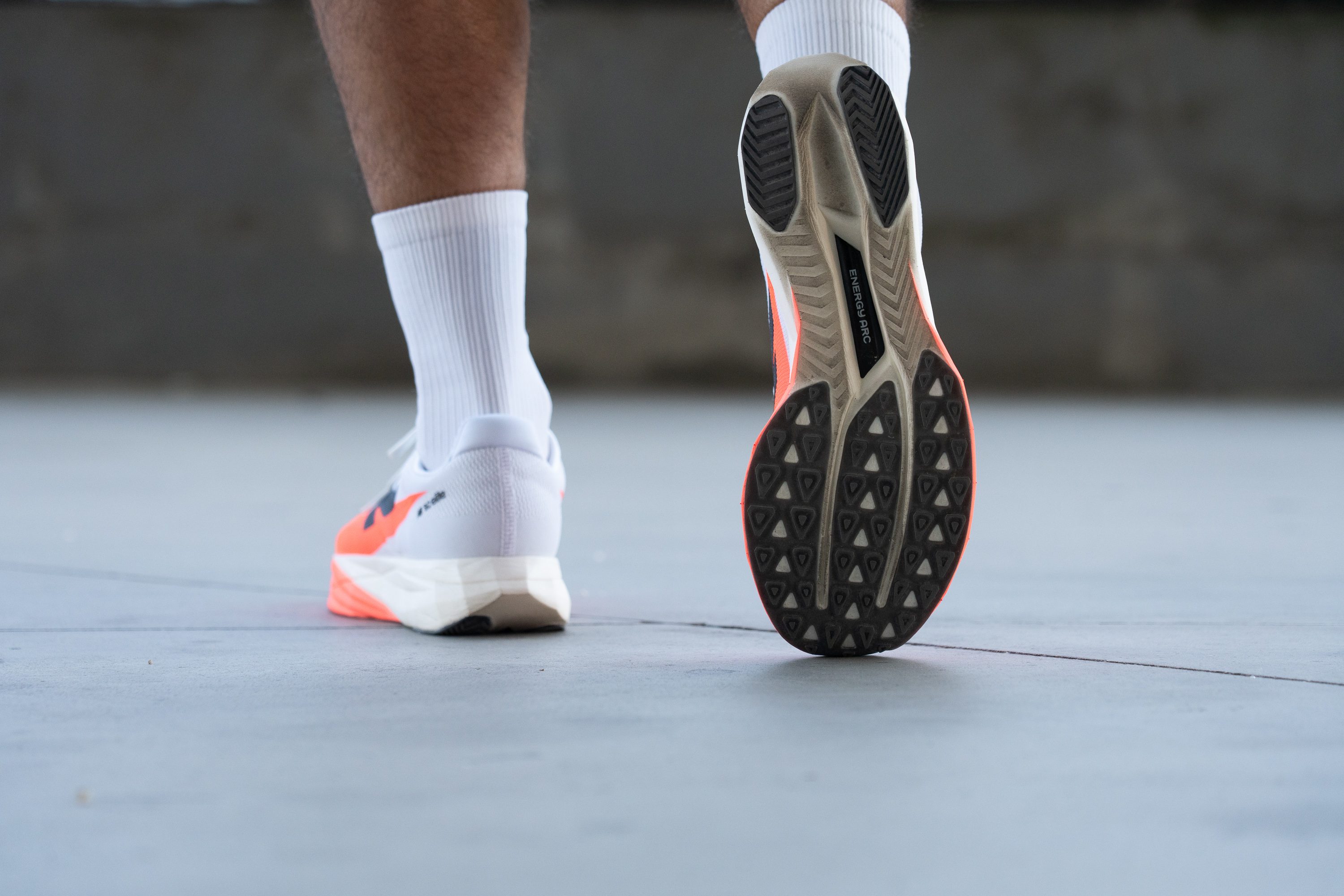
Flexibility / Stiffness
In our 30-degree bend test, the New Balance FuelCell SuperComp Elite v5 proved to be more flexible than its predecessor and most carbon-plated supershoes with just 16.2N.
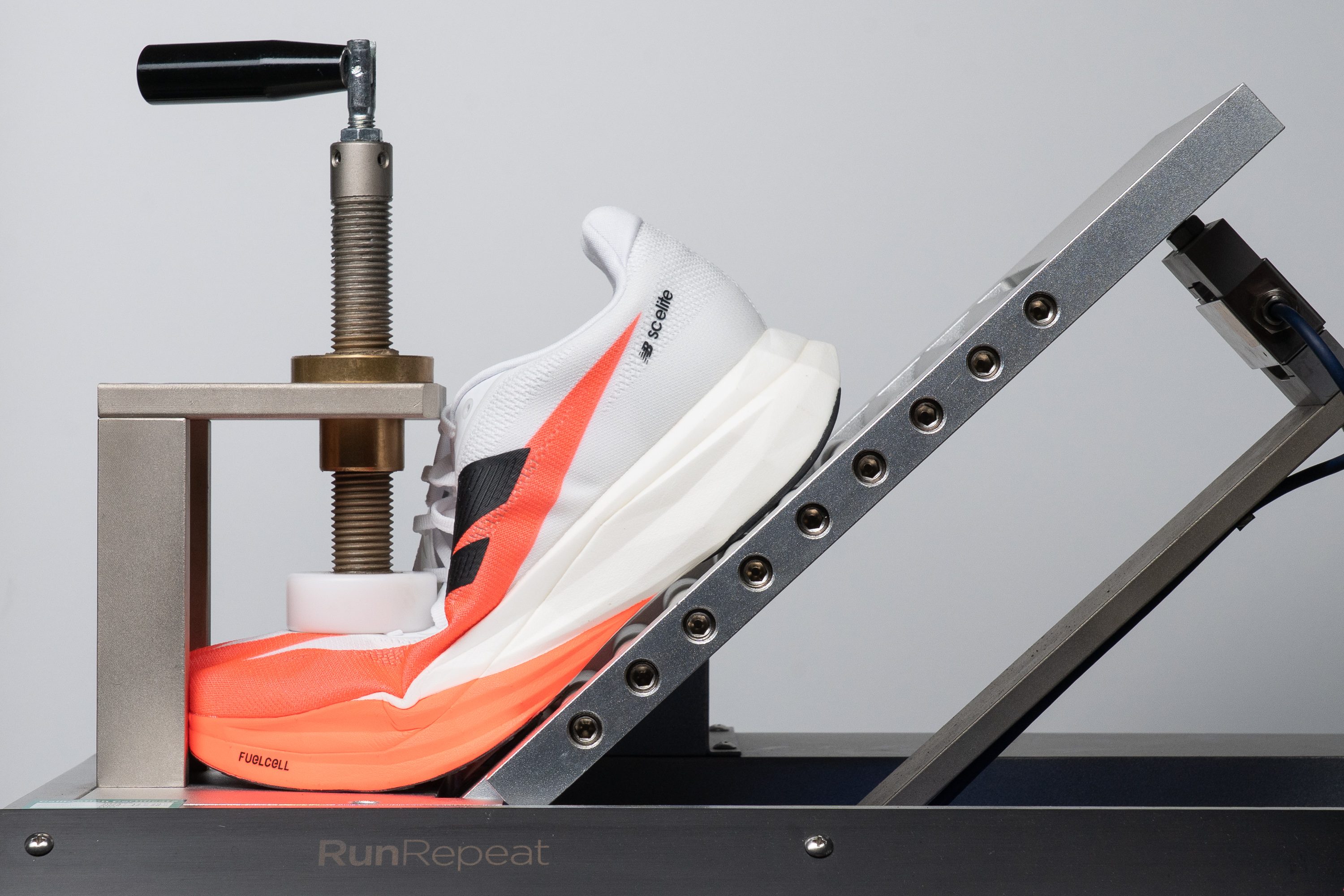
| FuelCell SuperComp Elite v5 | 16.2N |
| Average | 15.3N |
Weight
Weight had always been one of the biggest issues for NB in the Elite series, as every version felt heavier than most competitors. With the v5, New Balance finally fixed that, dropping the weight from 8.2 oz (232g) to just 7.05 oz (198g).
The shoe now feels lighter, smoother, and no longer bottom-heavy. Still, brands like ASICS and Nike keep pushing the limits too, and they have managed to maintain a big gap over New Balance with their latest supershoes.
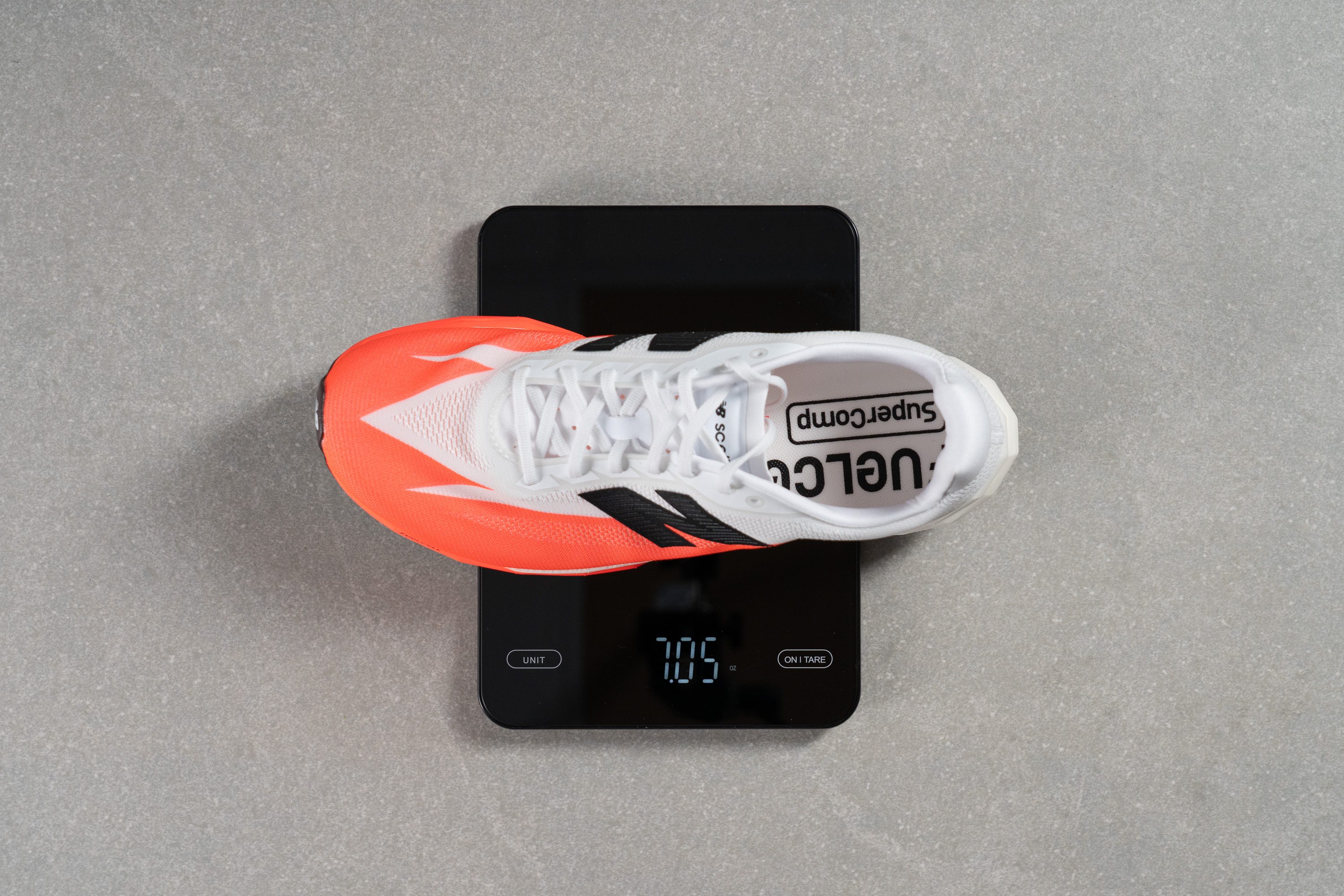
| FuelCell SuperComp Elite v5 | 7.0 oz (198g) |
| Average | 9.3 oz (264g) |
Breathability
The previous one was kind of a hit or miss depending on the runner, but this time New Balance clearly improved both quality and comfort.
We found that breathability is solid, achieving a 4 out of 5 in our test. This ensures good performance during hot races while keeping the foot cozy on colder days.
The upper has very little structure, as expected for a supershoe. It’s fully focused on saving weight and maintaining excellent airflow across the entire forefoot and midfoot.
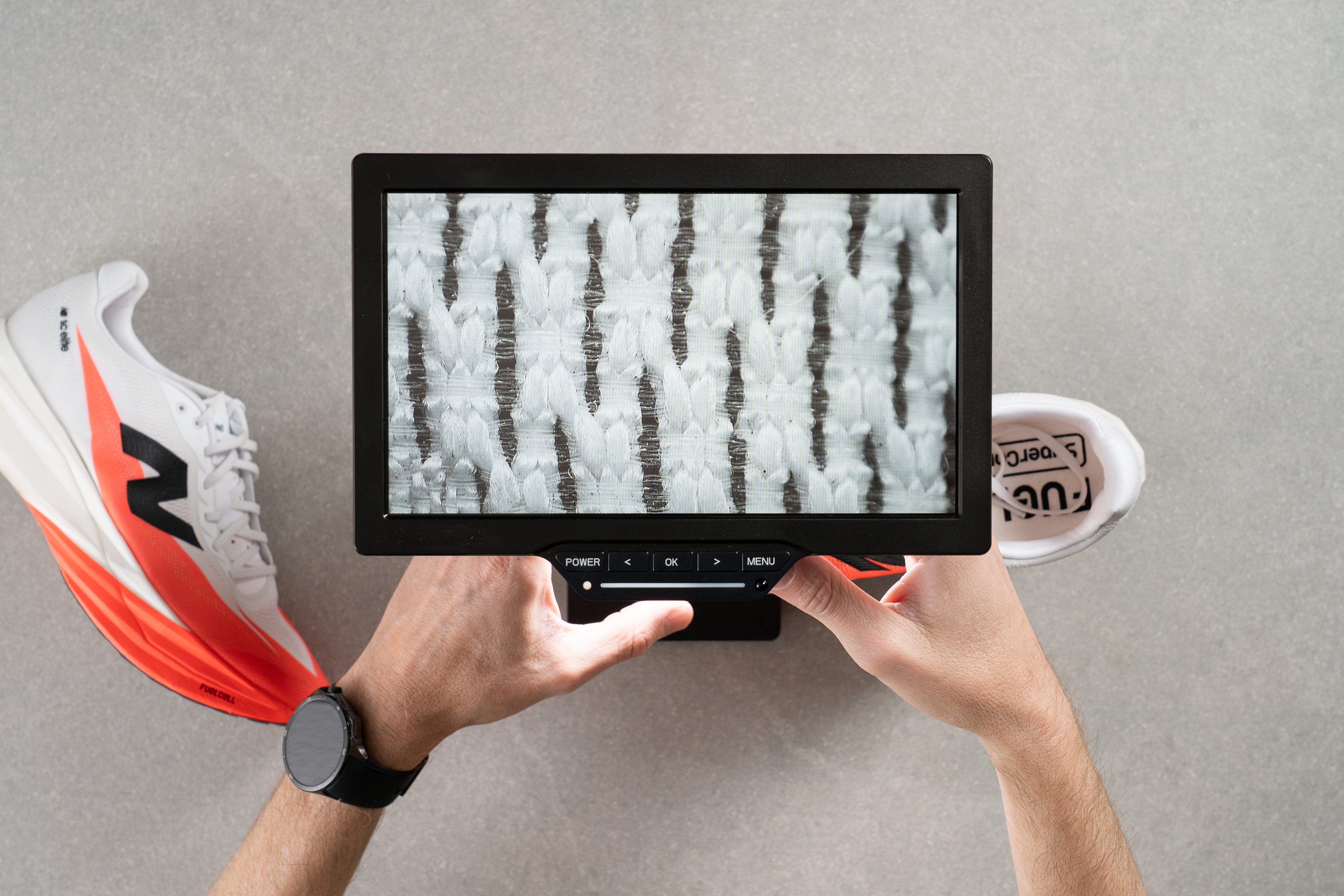
Under the microscope, we discovered a woven mesh that blends nylon and polyester yarns in a precise and carefully engineered pattern. The overall craftsmanship matches the shoe’s premium price tag.
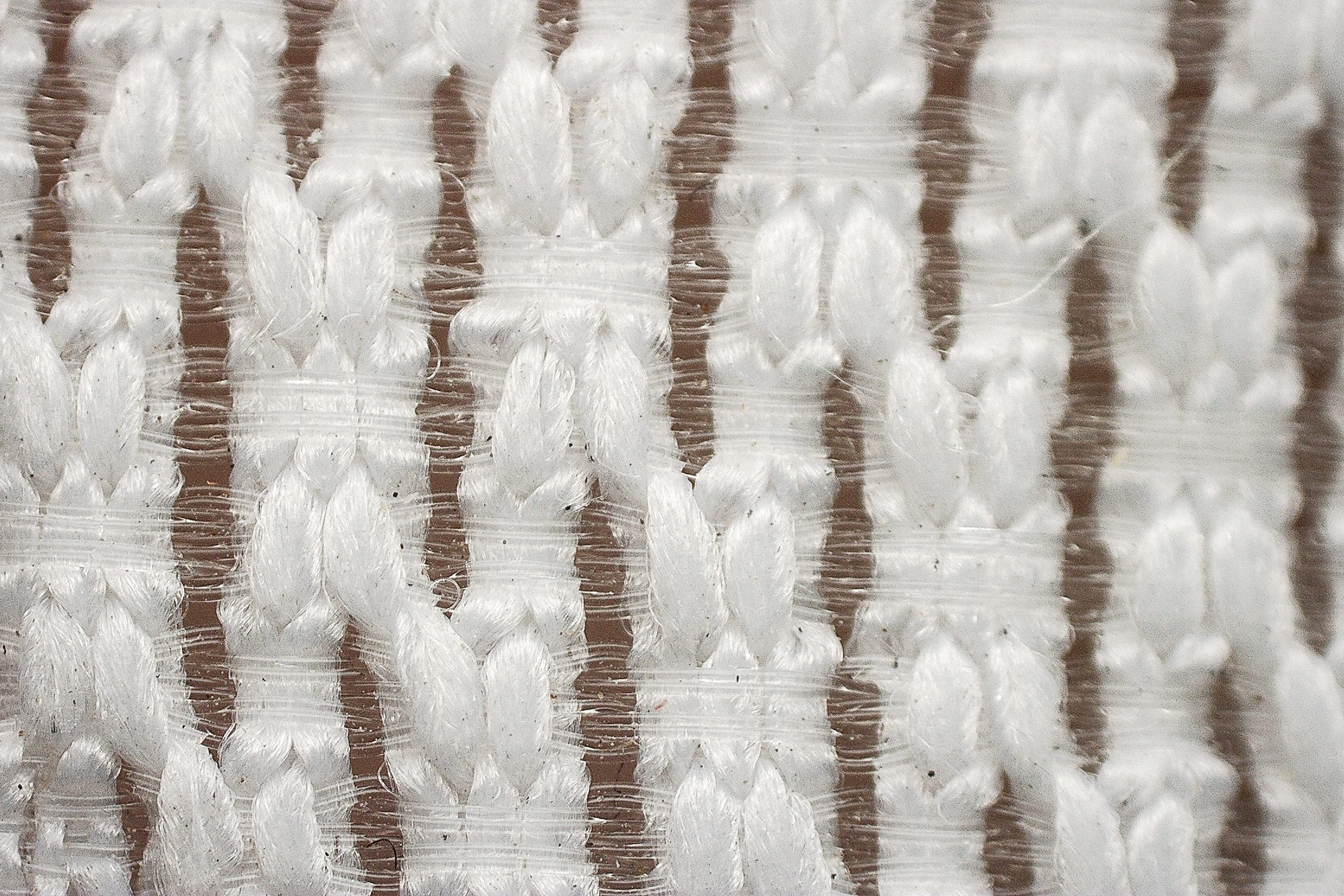
Overall, we really liked this new upper. The material feels softer, more comfortable on foot, and New Balance completely fixed the tongue and heel issues of the Elite v4.
| FuelCell SuperComp Elite v5 | 4 |
| Average | 3.7 |
Stability
Lateral stability test
In our opinion, the FuelCell SuperComp Elite v5 is only designed for neutral runners with efficient running mechanics.
It’s not a shoe we can recommend for those with any degree of pronation, even mild. While there’s a small amount of forefoot support, the heel is now extremely narrow, leaving everyone to rely on their own stability throughout the stride.
Torsional rigidity
As expected from any modern competition shoe, torsional rigidity is high. However, the SuperComp Elite v5 stands out by scoring a 4 instead of the usual 5, offering a slightly more forgiving feel and making it friendlier for newer runners.
| FuelCell SuperComp Elite v5 | 4 |
| Average | 3.5 |
Heel counter stiffness
The heel counter is impressively well padded for a supershoe, showing once again that New Balance favors comfort over extreme weight savings. Still, it remains quite flexible and scored 2 out of 5 in our stiffness test.
| FuelCell SuperComp Elite v5 | 2 |
| Average | 2.9 |
Midsole width - forefoot
We measured the forefoot at 107.0 mm, giving the shoe a slimmer, more traditional supershoe profile and moving away from wider designs. This update makes it feel smoother at faster paces like 5K or 10K efforts, and it also excels during mile repeats.
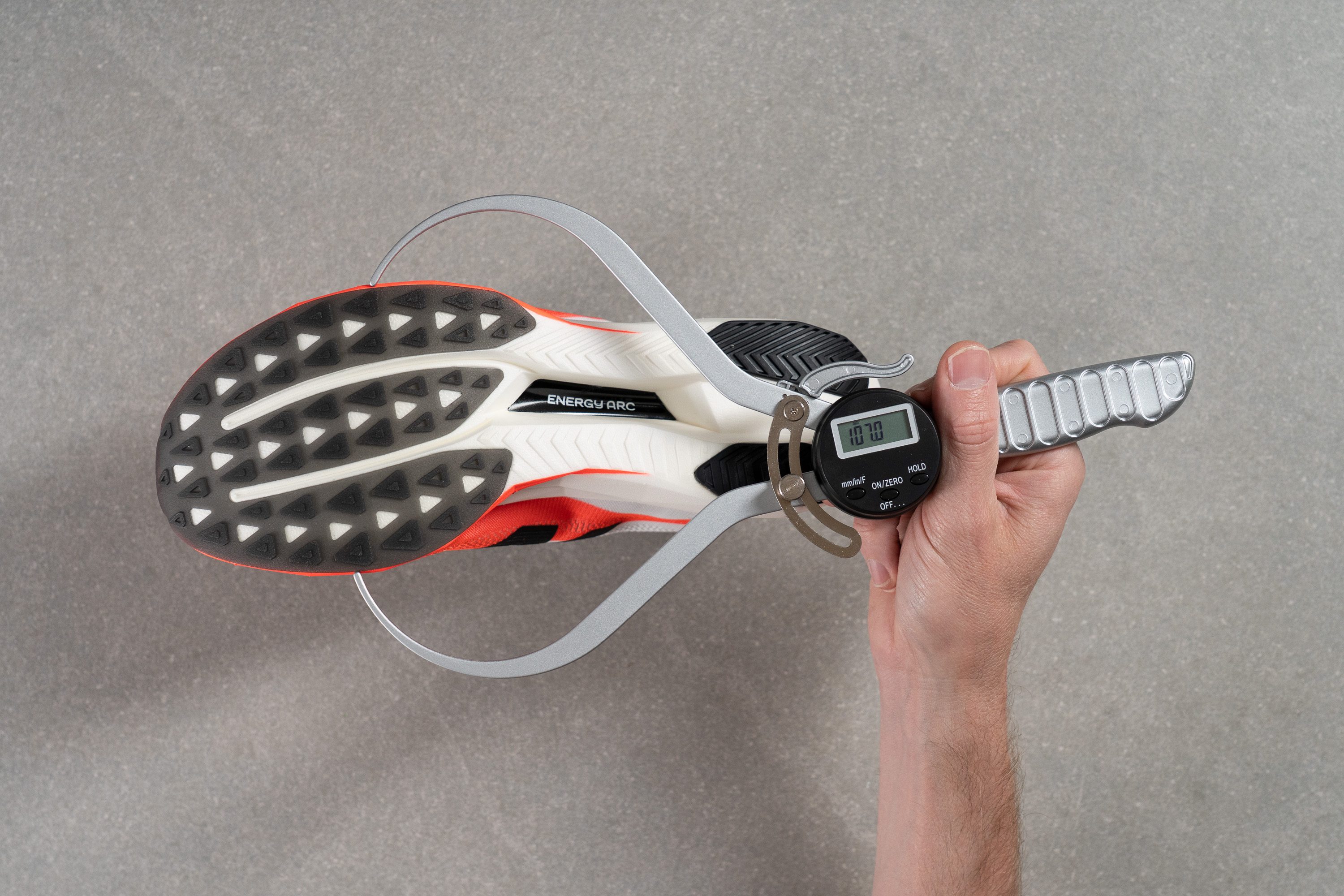
| FuelCell SuperComp Elite v5 | 107.0 mm |
| Average | 114.4 mm |
Midsole width - heel
We discovered one of the biggest design changes from the FuelCell SuperComp Elite v4 in the heel area. At just 71.6 mm, the Elite v5 is remarkably narrow, going all-in on a race-oriented, weight-saving approach that prioritizes agility over stability.
Those who enjoyed the average-width 88.7 mm heel of the v4 might find this version too radical, as it’s now among the narrowest we’ve ever measured. In fact, it's almost like a track spike!
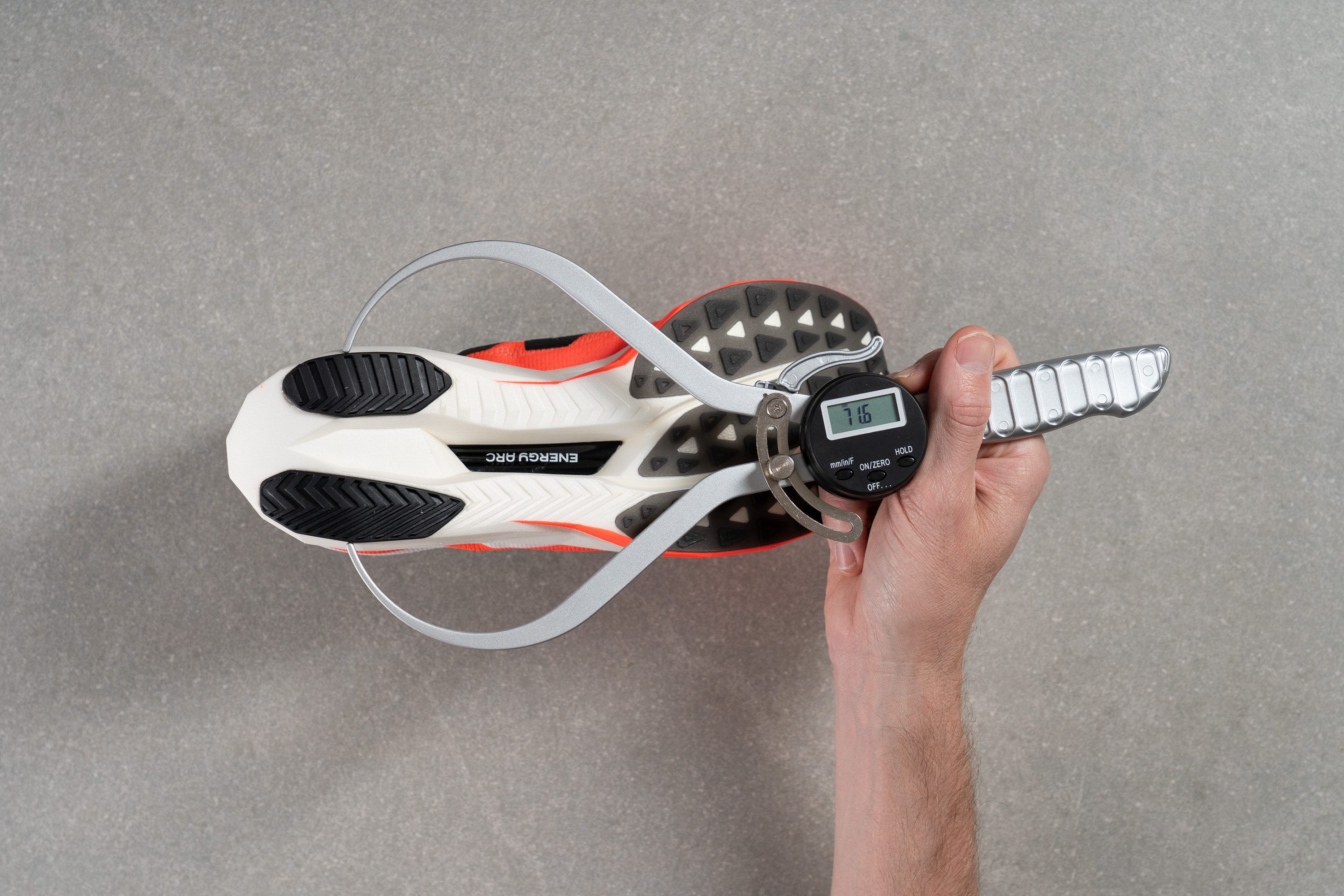
| FuelCell SuperComp Elite v5 | 71.6 mm |
| Average | 90.7 mm |
Durability
Toebox durability
One common drawback of many supershoes is a fragile toebox, and the SuperComp Elite v5 followed that trend, scoring just 1/5 in our initial Dremel durability test.
| FuelCell SuperComp Elite v5 | 1 |
| Average | 2.6 |
Heel padding durability
We applied the Dremel to the heel padding area using the same settings: 2N of force and 5K RPM. The result came out slightly below average, but with a 3 out of 5 score, it’s nothing to worry about as they fixed the heel slippage issue.
| FuelCell SuperComp Elite v5 | 3 |
| Average | 3.4 |
Outsole durability
We then tested the outsole, eager to see how it performed since polyurethane-based rubbers have shown impressive grip but uncertain durability. In this case, we measured 1.1 mm of wear in the heel, a solid result.
| FuelCell SuperComp Elite v5 | 1.1 mm |
| Average | 1.1 mm |
Outsole thickness
We have no concerns with the outsole, as it features 3.5 mm of thickness.
That's an impressive amount for a supershoe, and places the Elite v5 again among the best options for runners who don’t mind trading a bit of weight for other features.
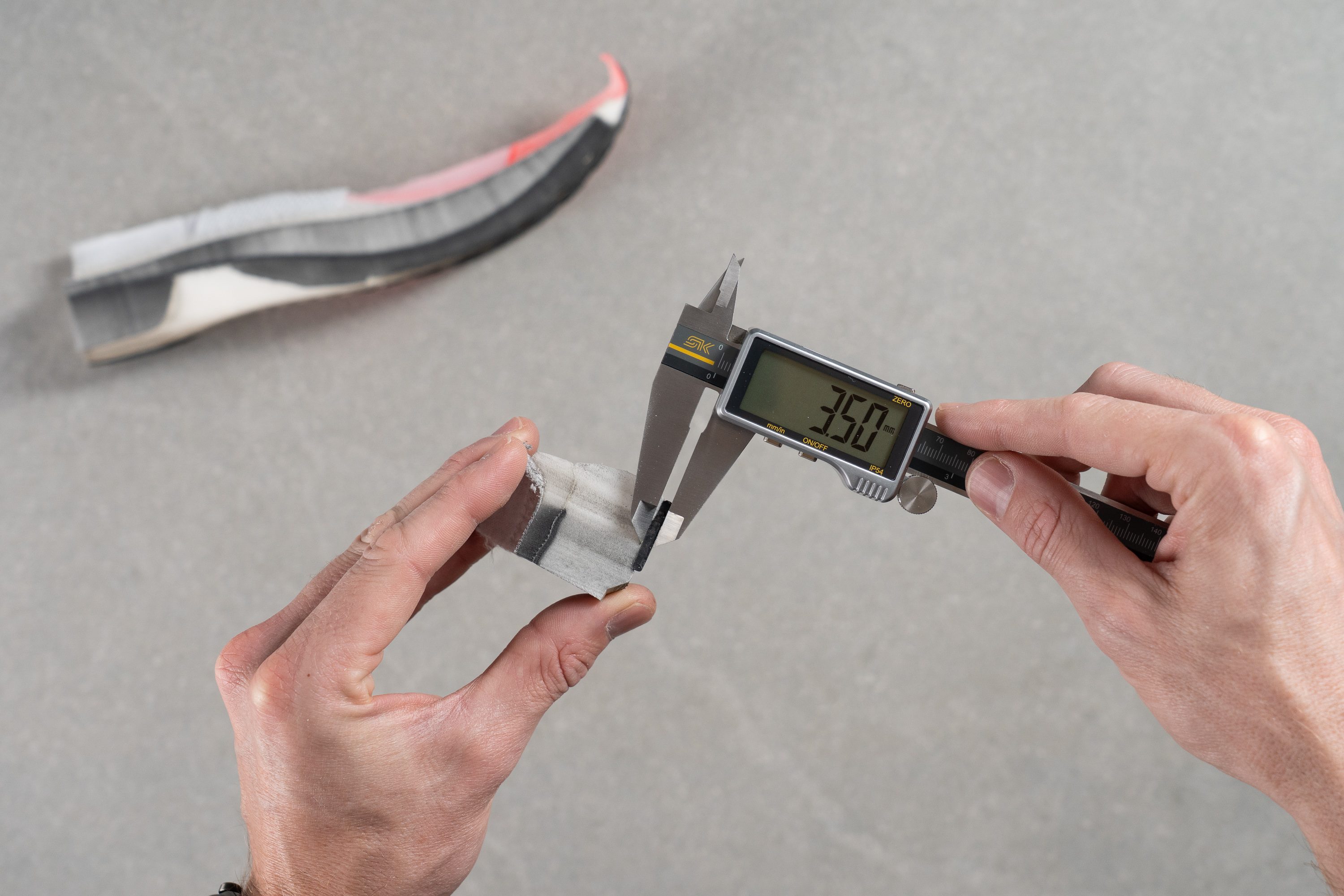
| FuelCell SuperComp Elite v5 | 3.5 mm |
| Average | 3.2 mm |
Misc
Insole thickness
The insole is slightly thinner than what’s common in running shoes, measuring 3.1 mm, which puts it right in line with most supershoe competitors.
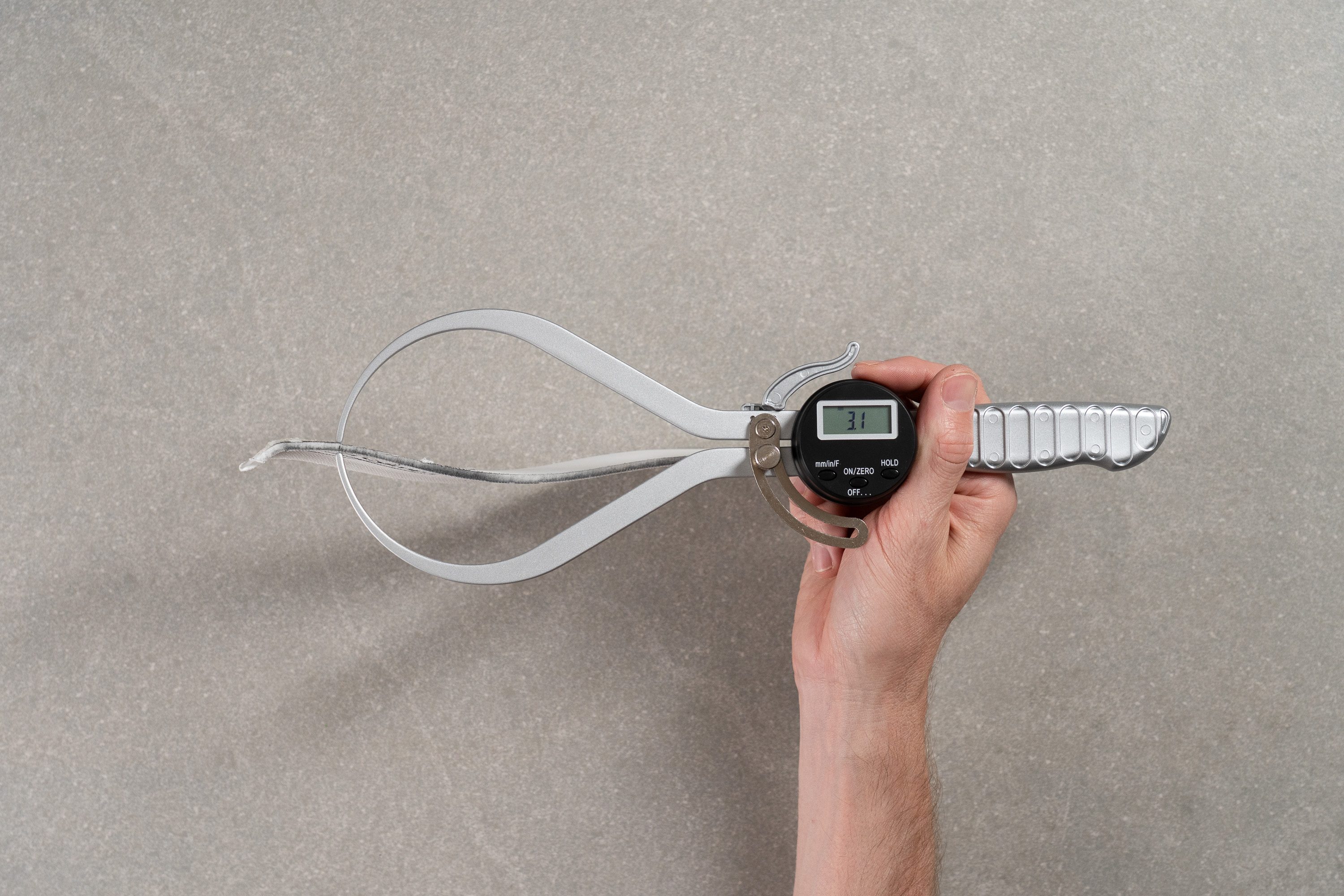
| FuelCell SuperComp Elite v5 | 3.1 mm |
| Average | 4.5 mm |
Removable insole
You can easily remove the insole and replace it with your preferred one. The Elite v5 is one of the few supershoes that allows this comfortably thanks to its well-shaped interior.
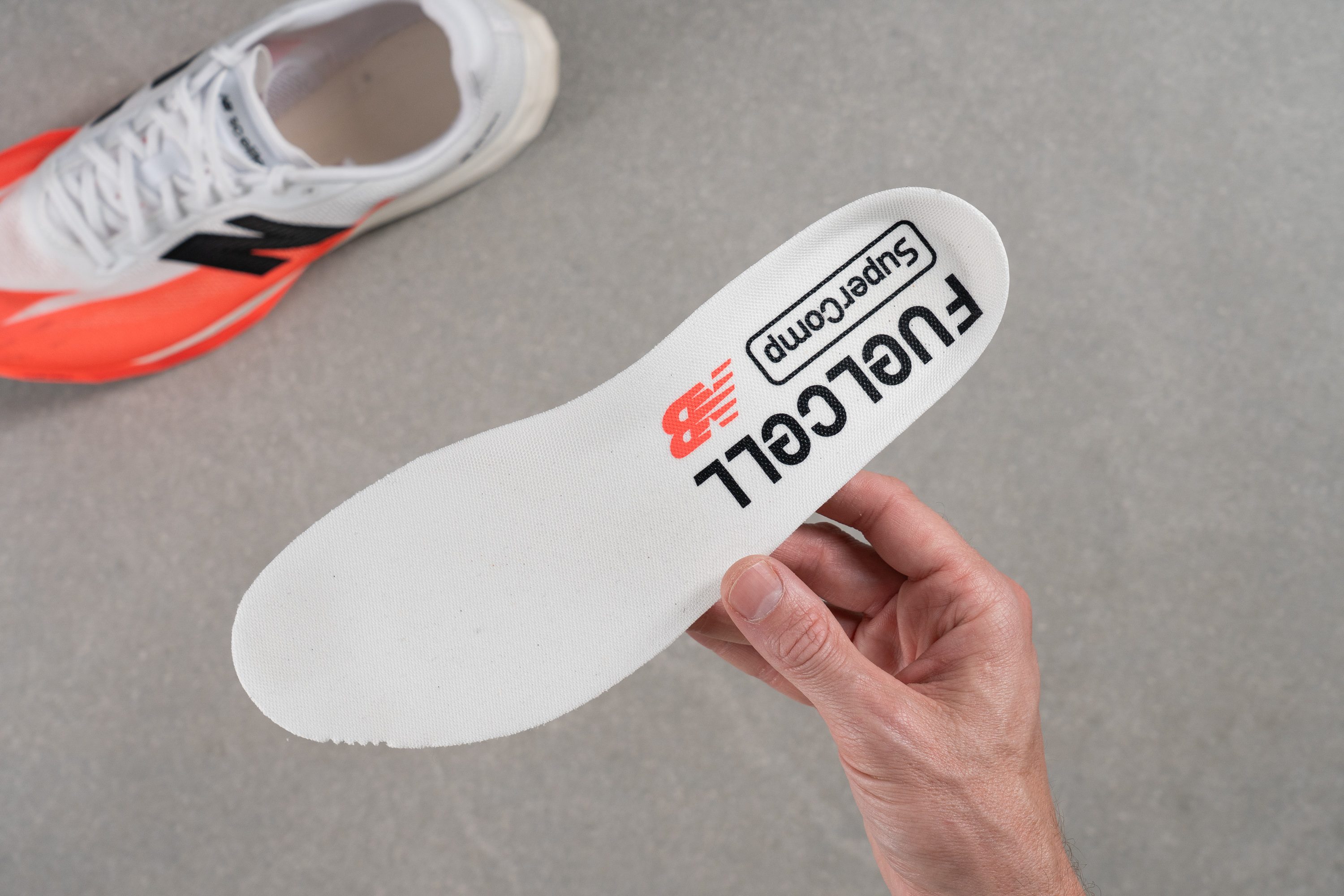
| FuelCell SuperComp Elite v5 | Yes |
Midsole softness in cold (%)
Thanks to its full-PEBA FuelCell midsole, we found only a slight 9% change in softness after 20 minutes in the freezer, which is an outstanding result.
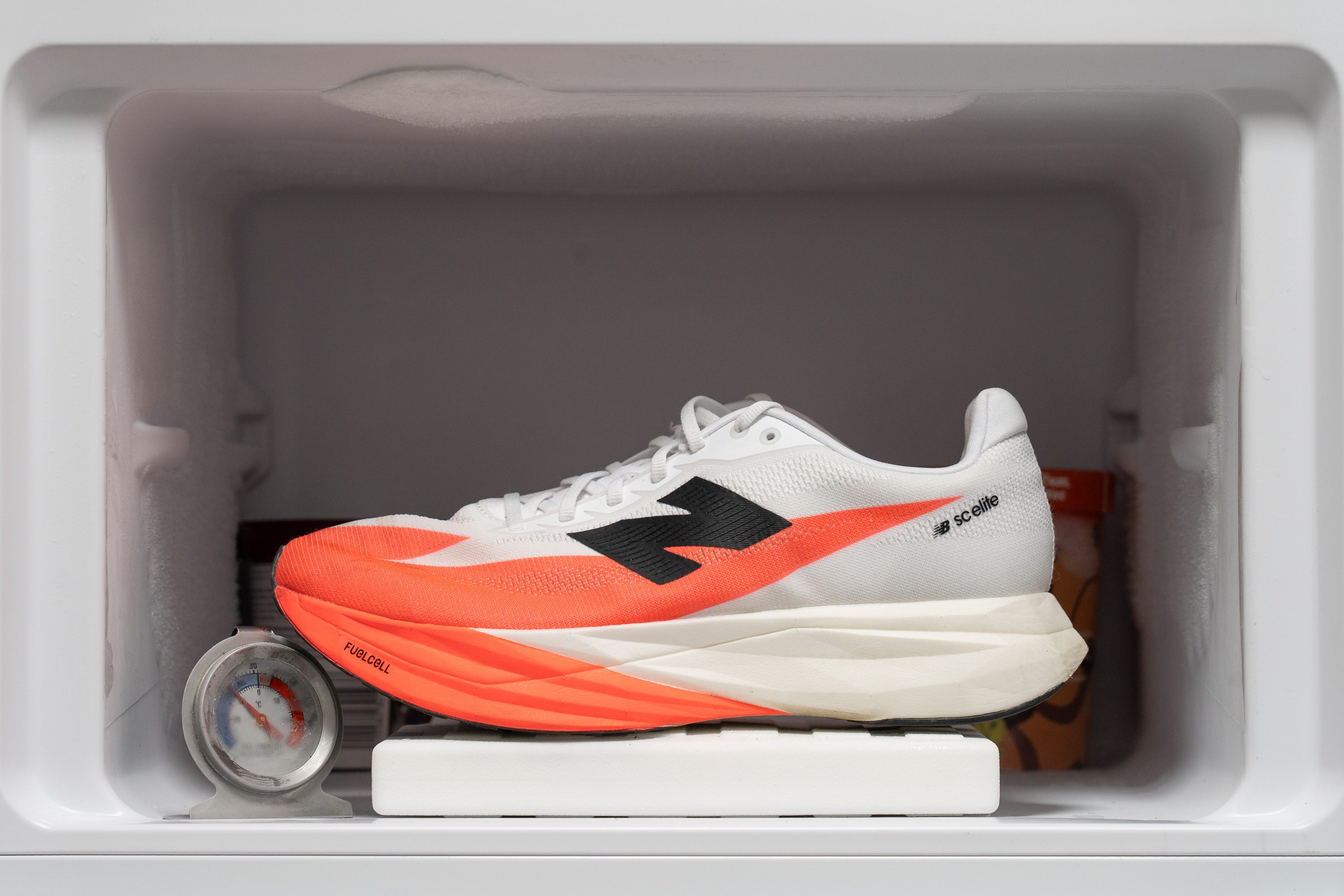
| FuelCell SuperComp Elite v5 | 9% |
| Average | 24% |
Reflective elements
As expected, the Elite v5 doesn’t include any reflective details, which is perfectly normal for a supershoe of this type.
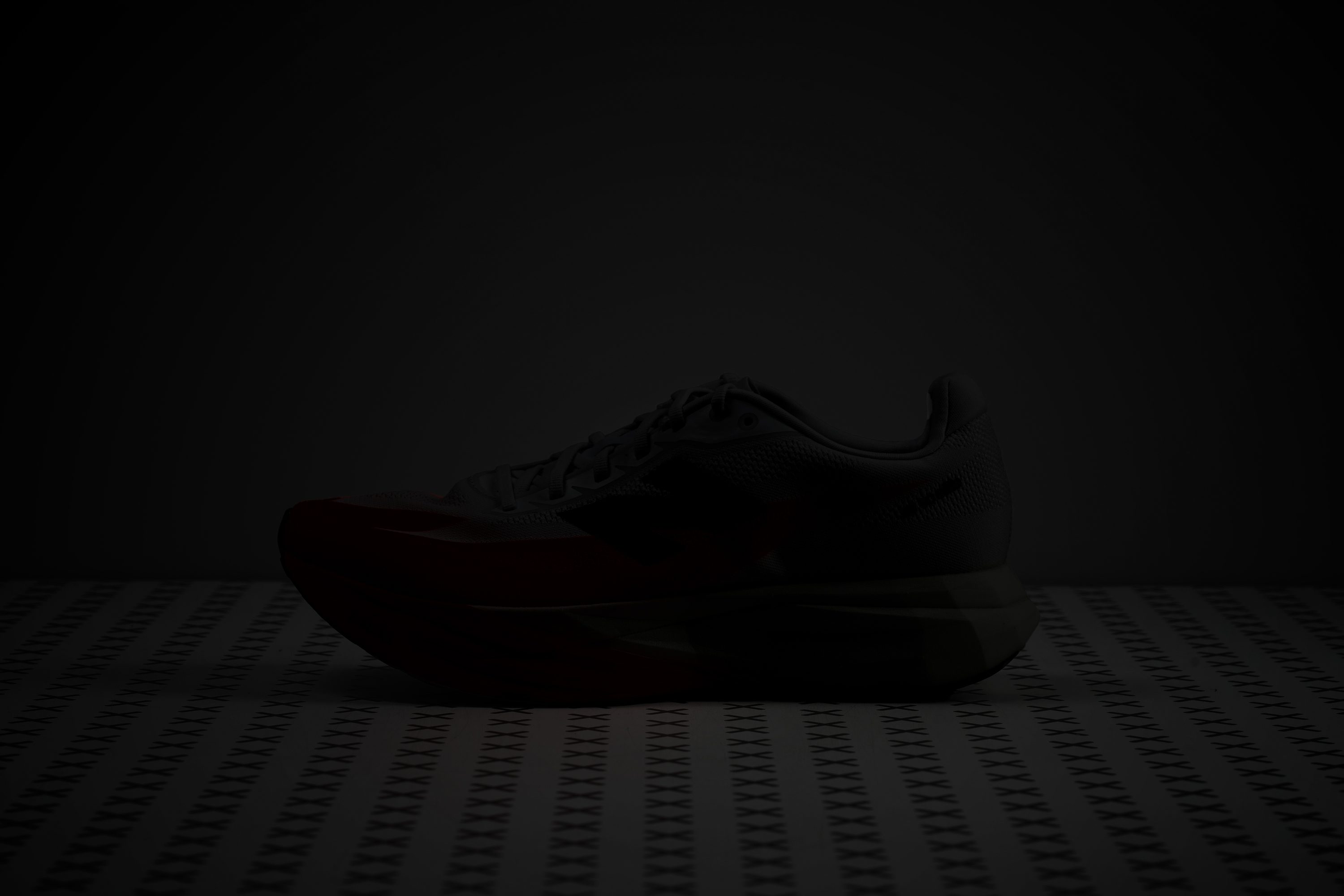
| FuelCell SuperComp Elite v5 | No |
Tongue padding
One area that New Balance really needed to improve was the tongue. Along with the heel, it was one of the weakest points in the previous version, as it was simply too short and unreliable.
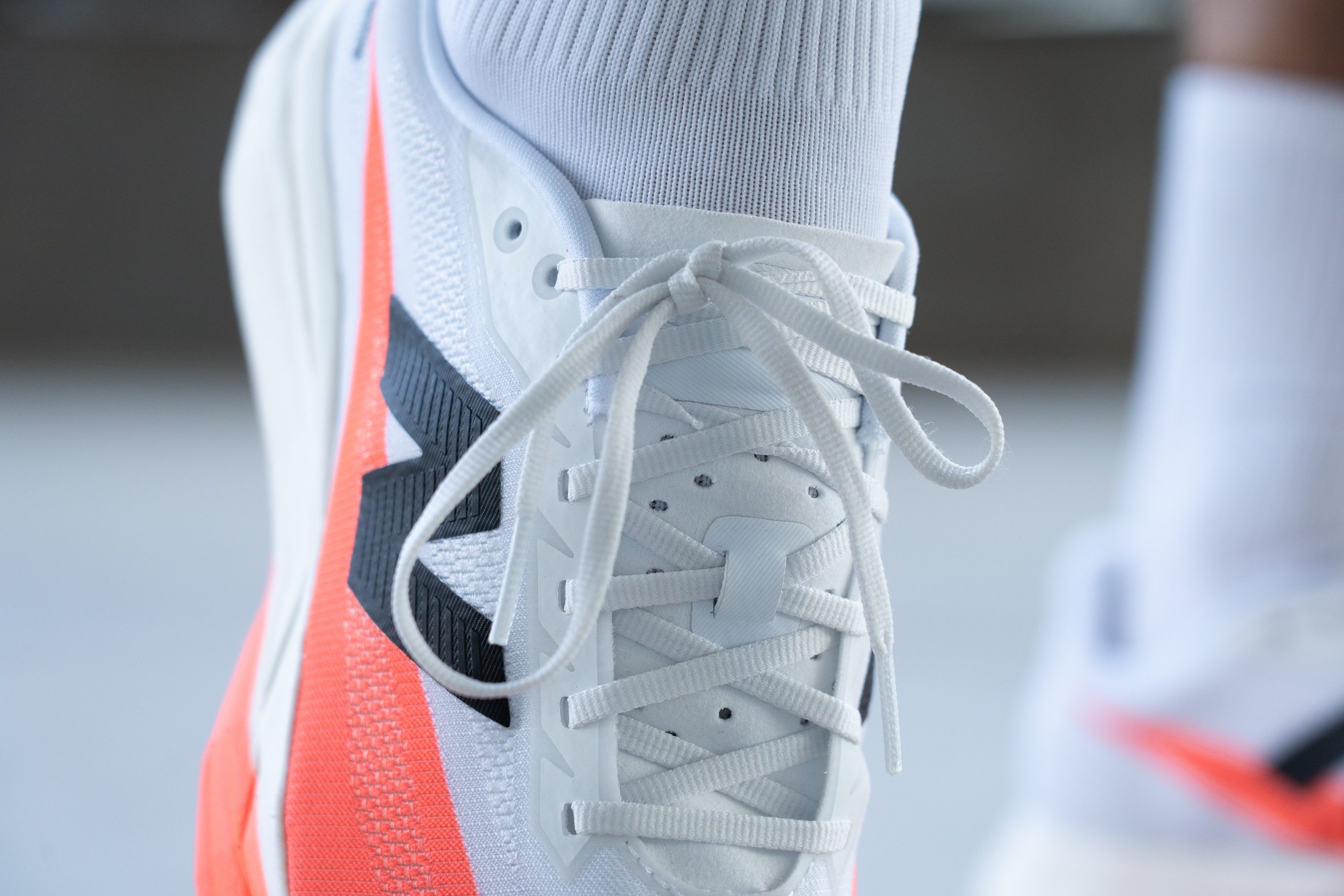
Now it’s much better. We found a 1.0 mm thin tongue that stays securely in place and it's a bit longer, though still feels short compared to other shoes. However, we believe it’s time for New Balance to upgrade the laces with a more high-grip, textured design.
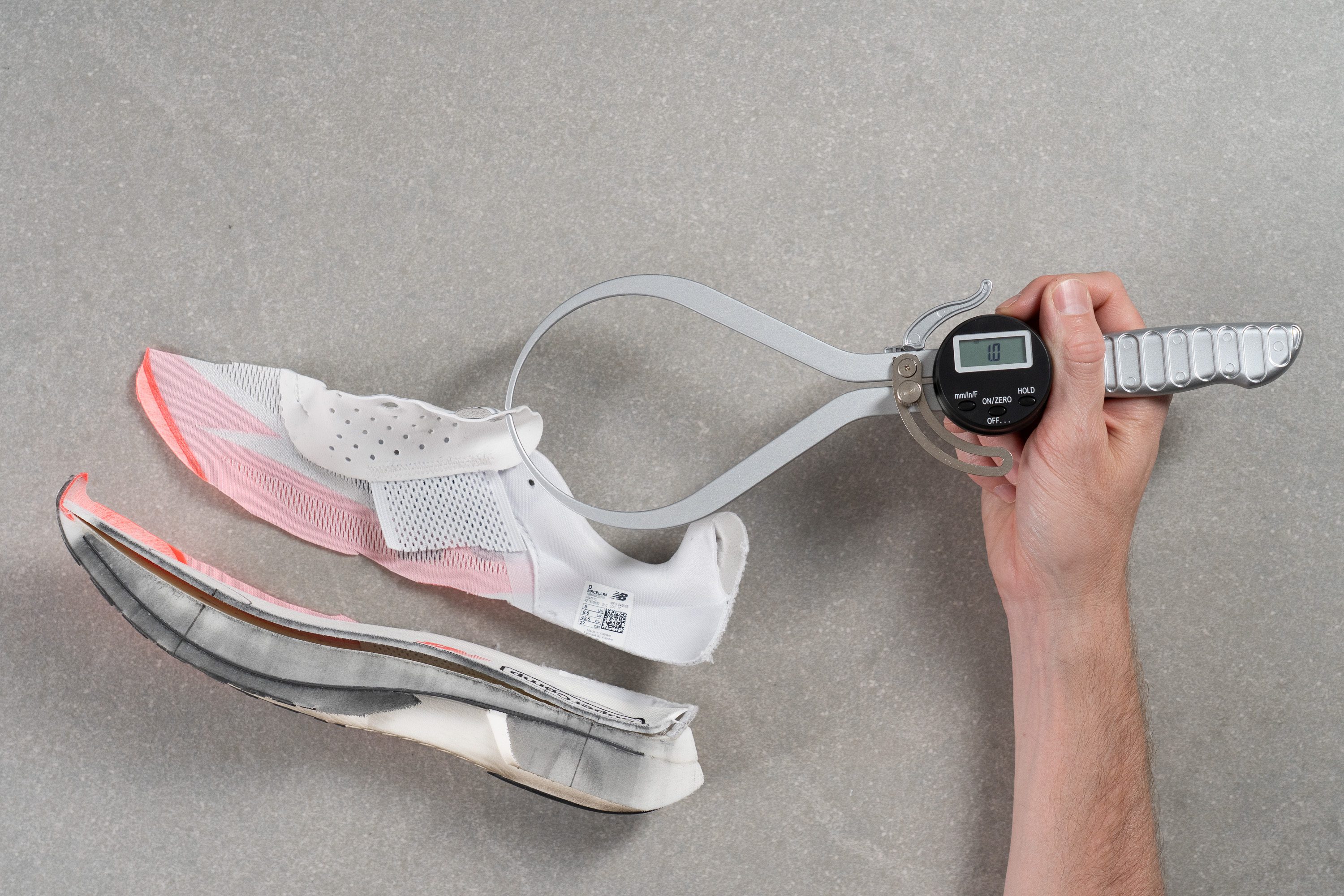
| FuelCell SuperComp Elite v5 | 1.0 mm |
| Average | 5.8 mm |
Tongue: gusset type
One of the things we liked most about the Elite v5 is its superb lockdown. Indeed, it’s one of the few supershoes featuring a tongue attached to the sides, and we discovered that New Balance managed to achieve this while keeping the shoe impressively lightweight.
We understand that when pushing design limits it’s hard to include this feature, but for most supershoes, it should definitely be possible.
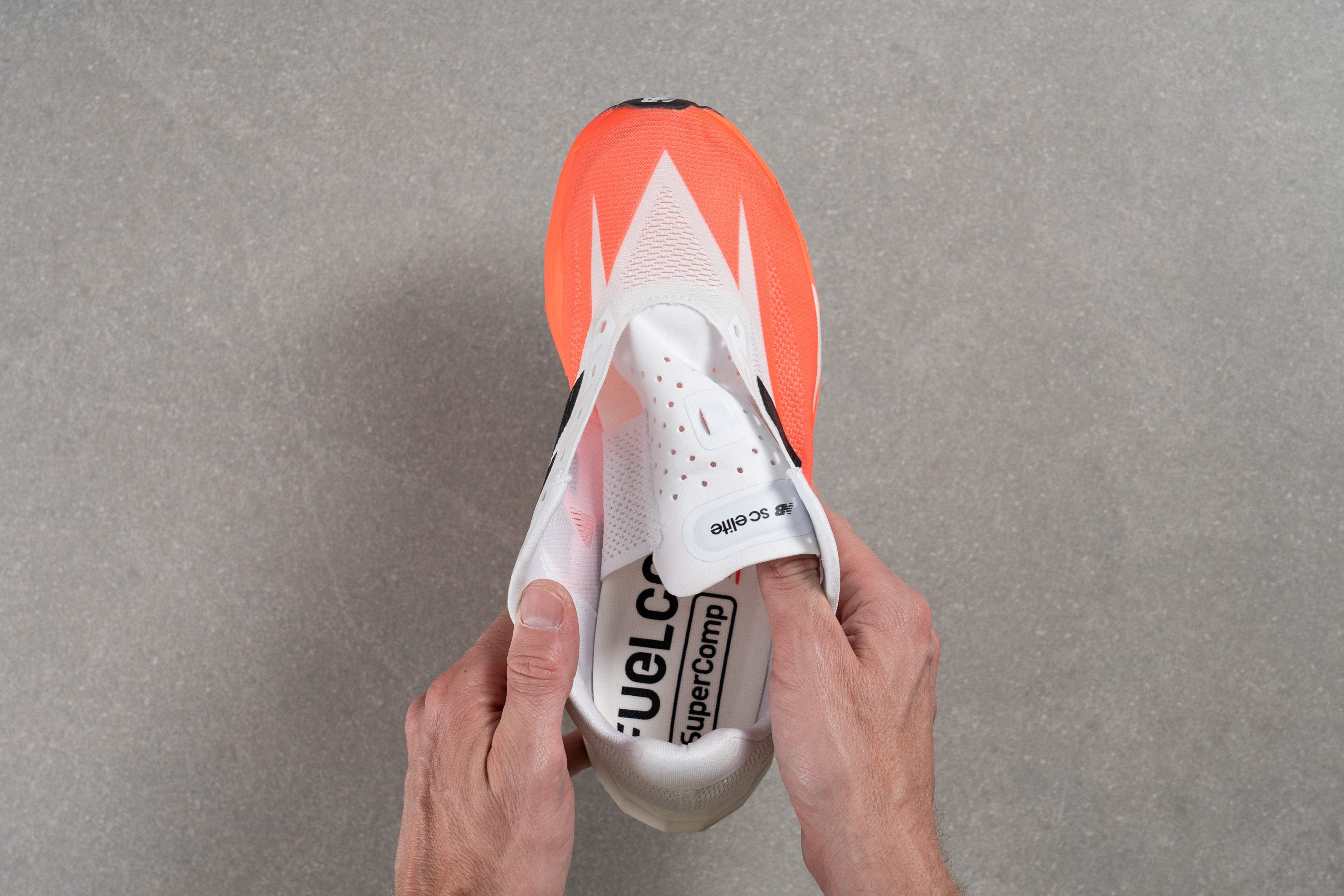
| FuelCell SuperComp Elite v5 | Both sides (semi) |
Price
We believe the FuelCell SuperComp Elite v5 is fairly priced considering its performance and upgrades. Yes, it’s expensive, but so is every top-tier supershoe featuring premium foam and a full-length carbon plate.
However, since the SC Elite never was the go-to choice for most runners when it comes to supershoes, we think New Balance could have lowered the price of version 5 by 10 or 20 dollars to attract undecided buyers who usually end up choosing the more popular options.
| FuelCell SuperComp Elite v5 | $265 |
| Average | $152 |
Heel tab
The heel design is sleek, lacks a finger-loop tab to save weight and comes as a much-needed improvement over version 4. It now feels more comfortable and secures the heel better, effectively preventing any unwanted slippage or rubbing.
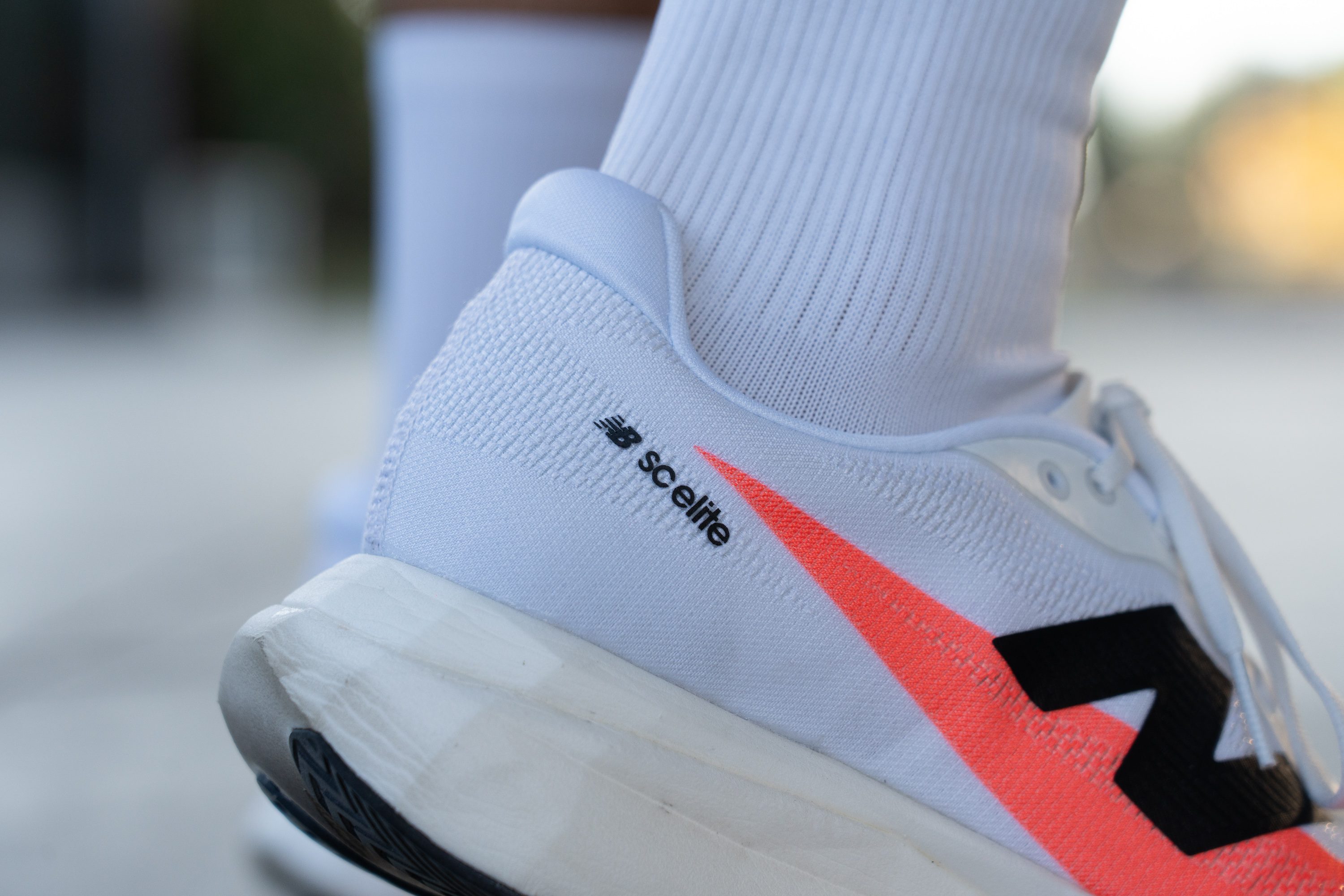
| FuelCell SuperComp Elite v5 | None |

